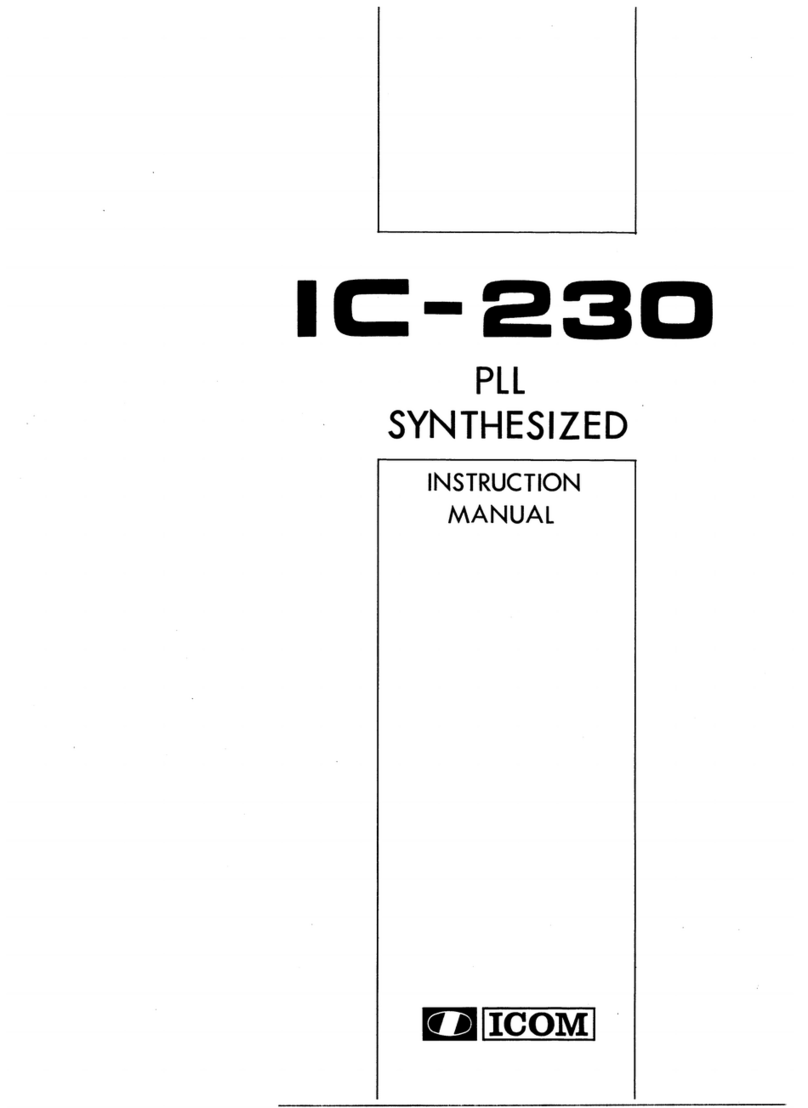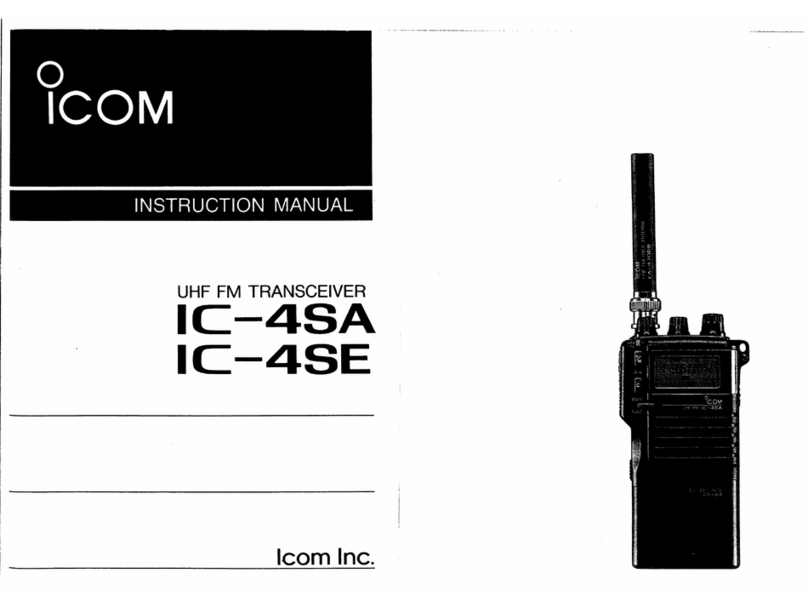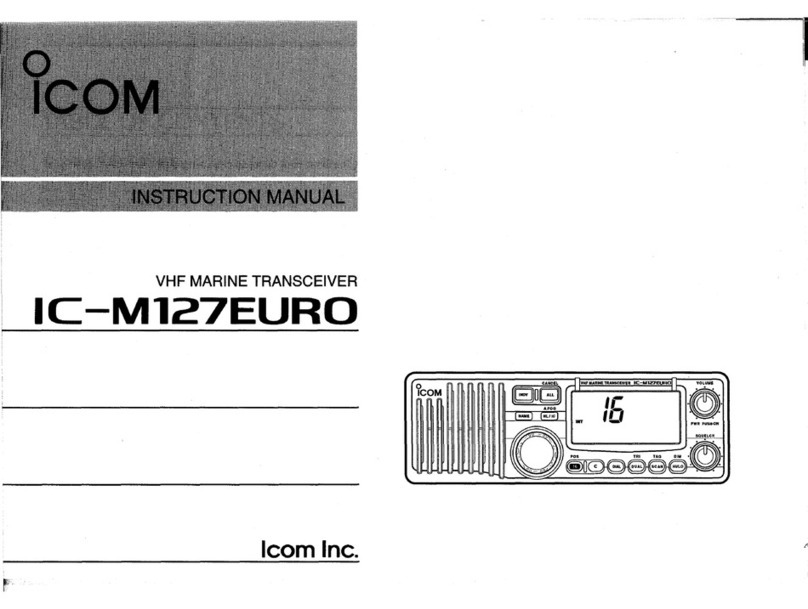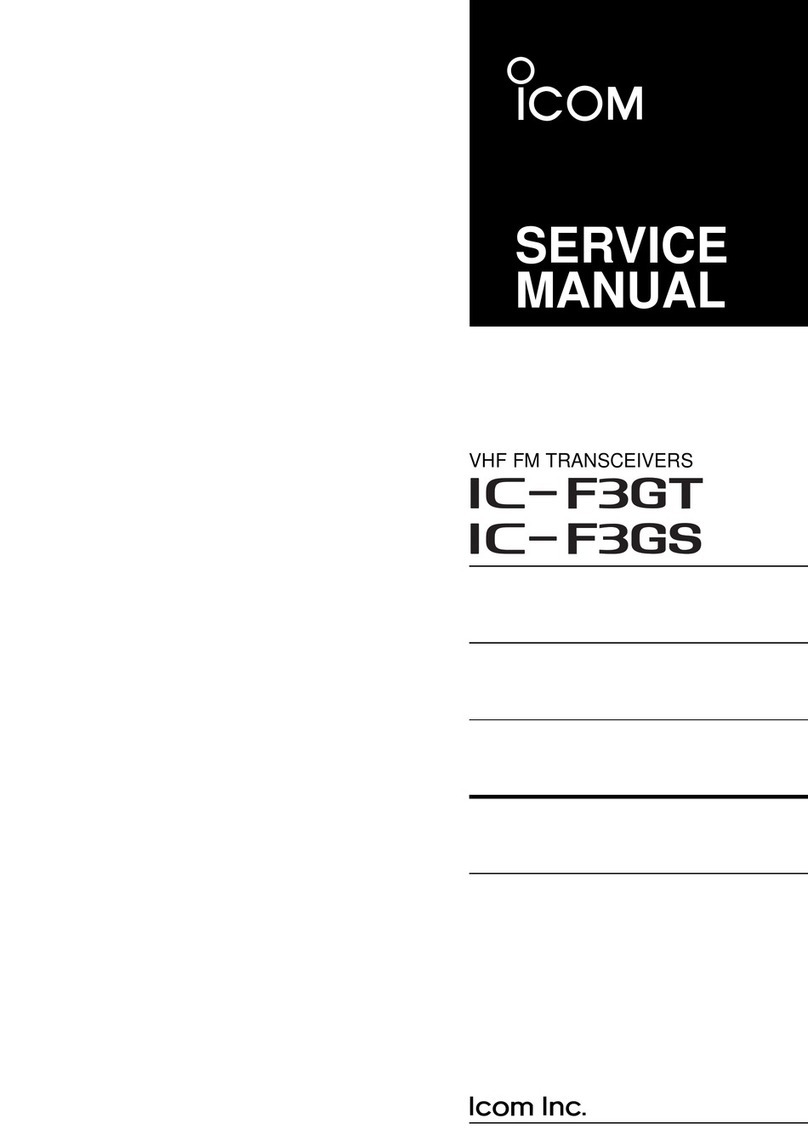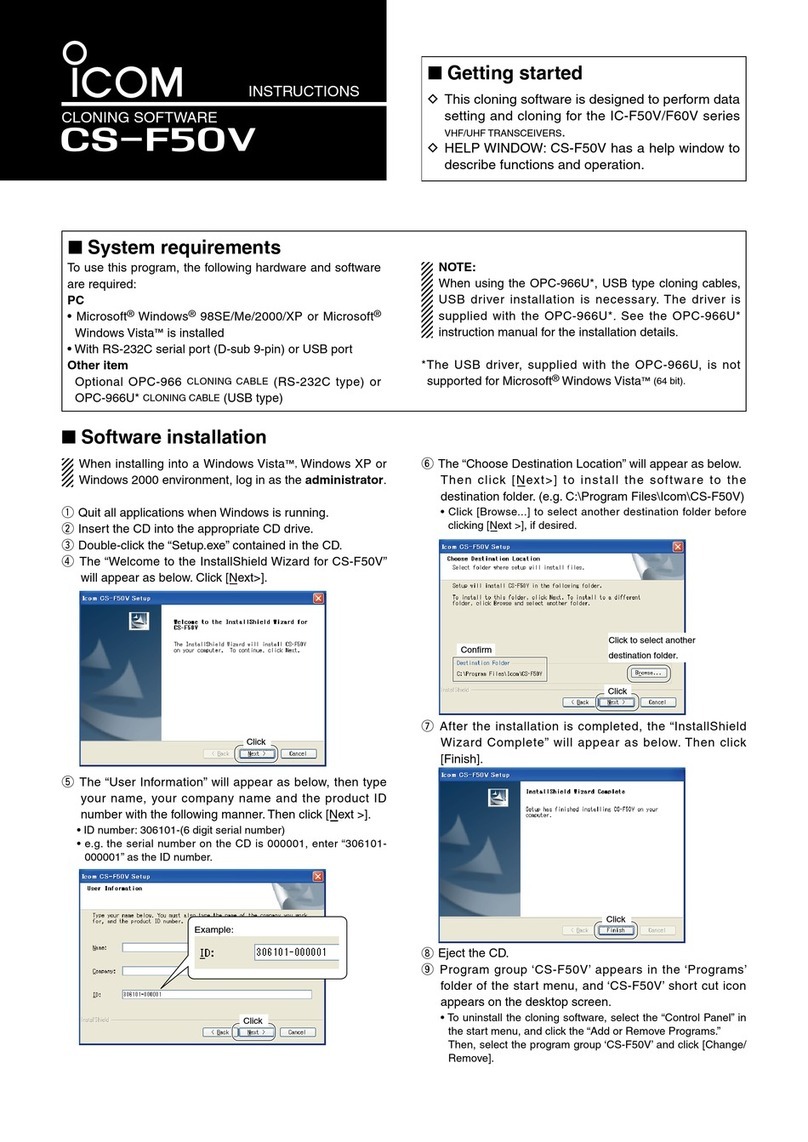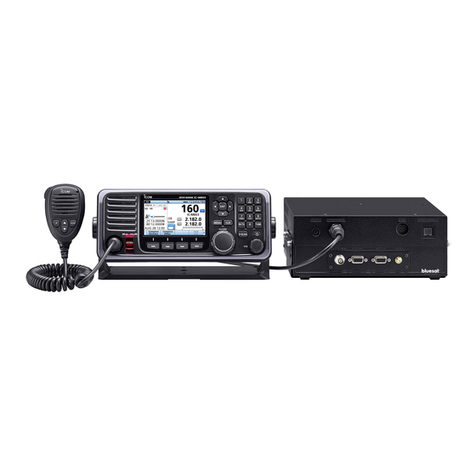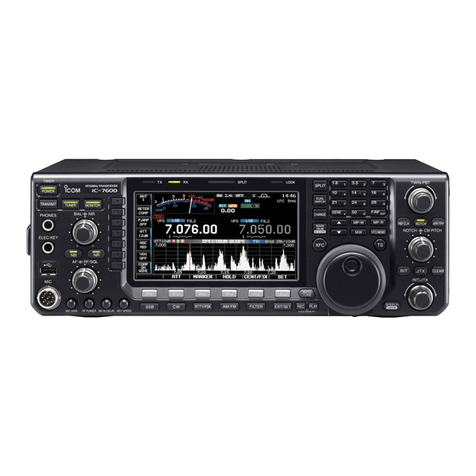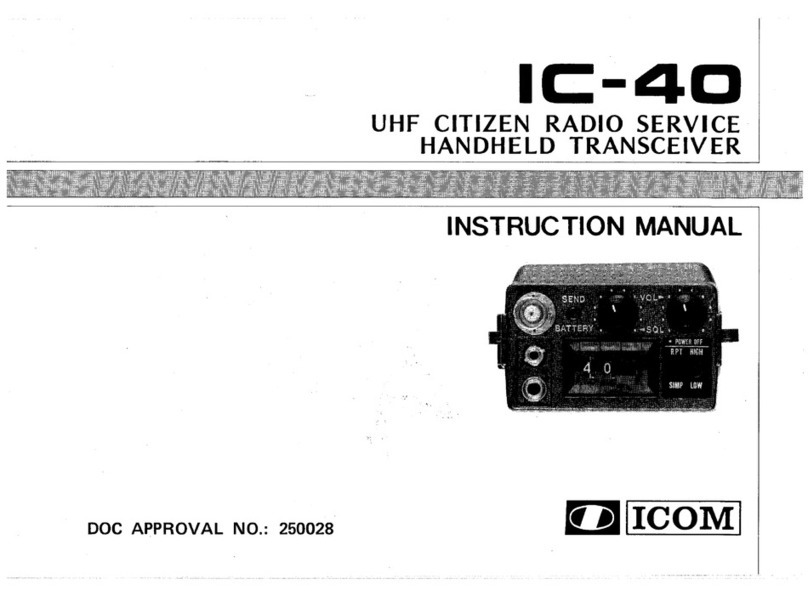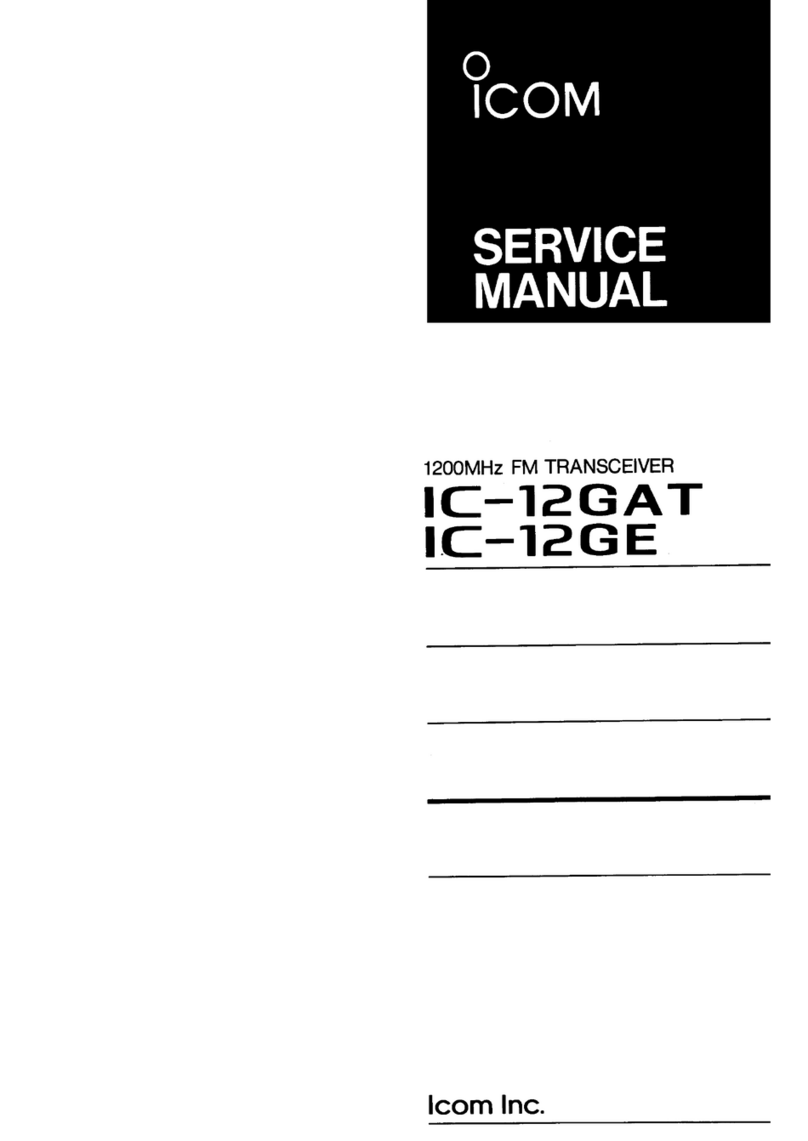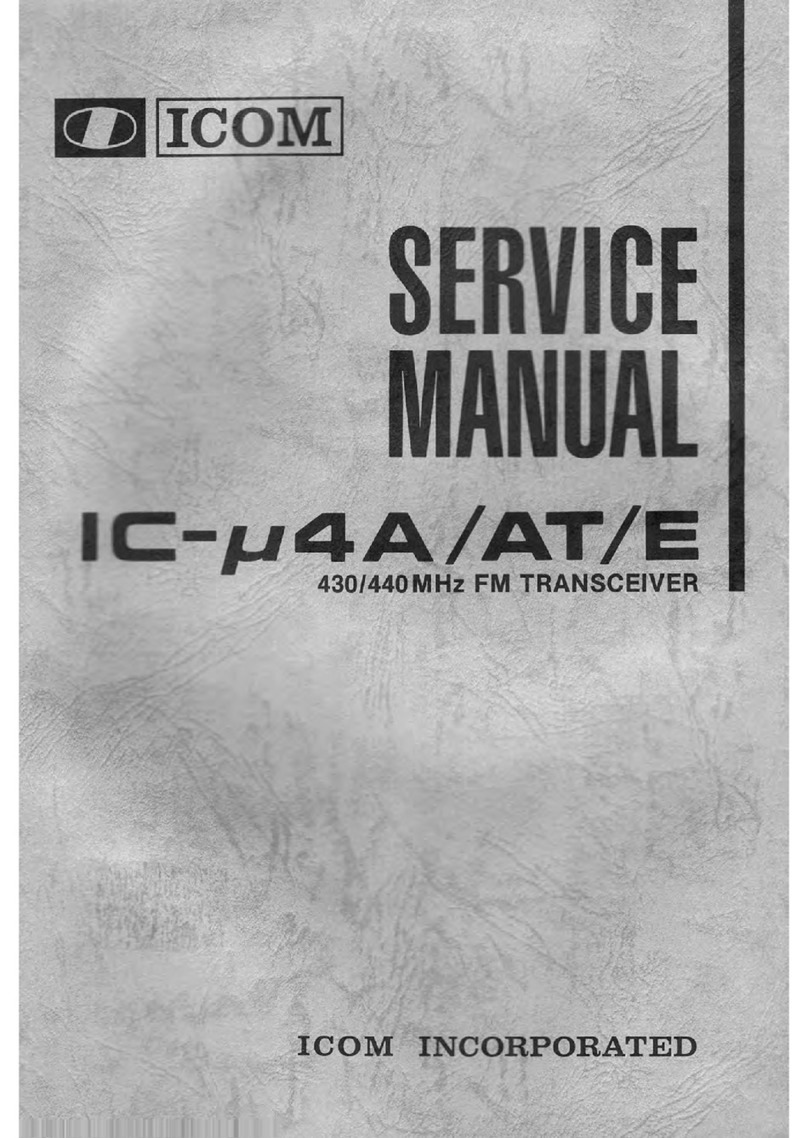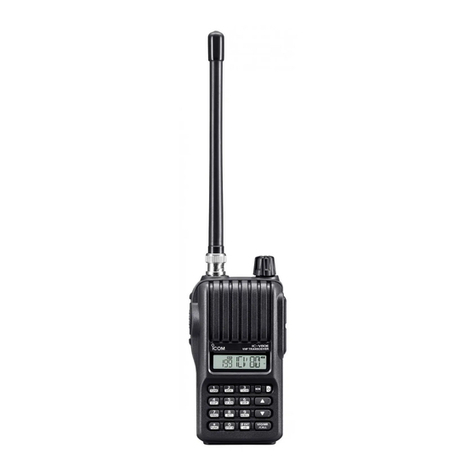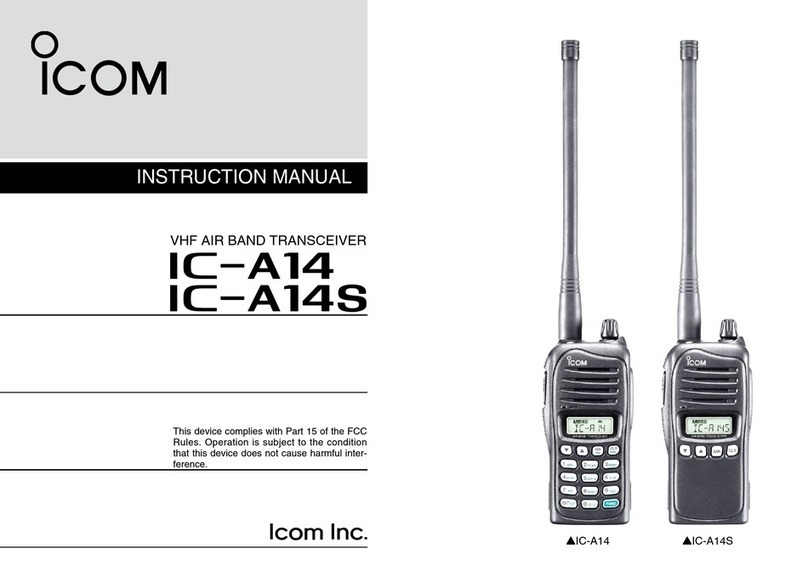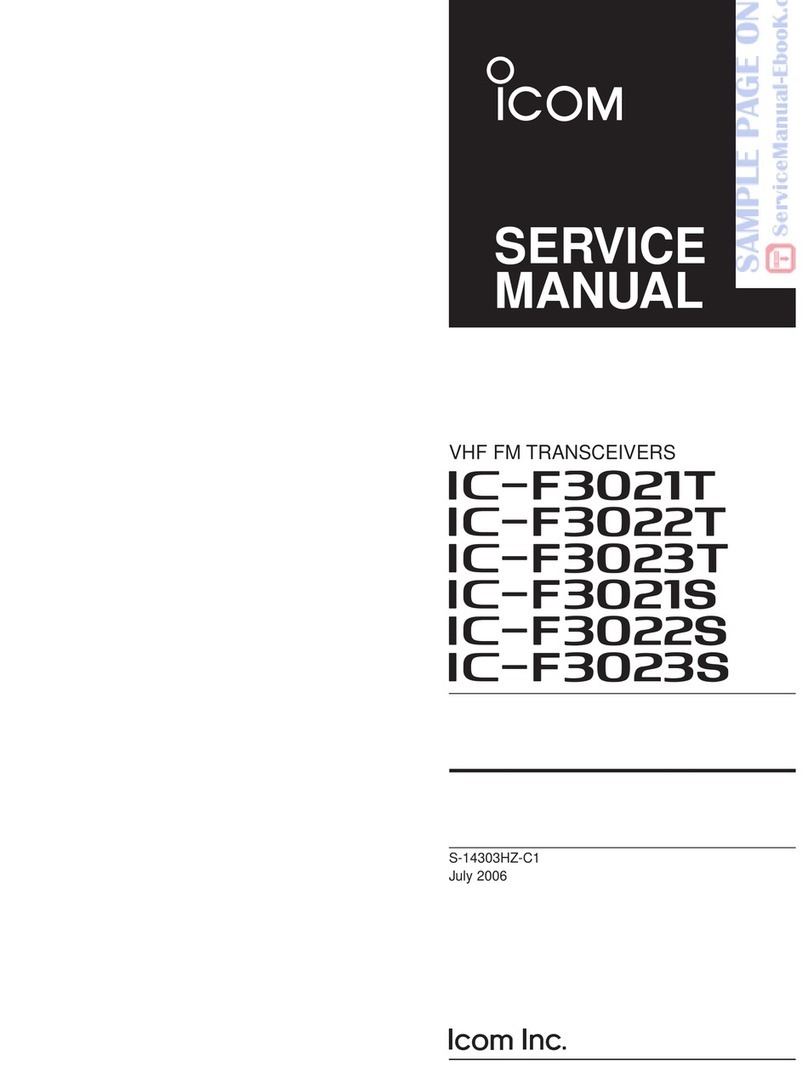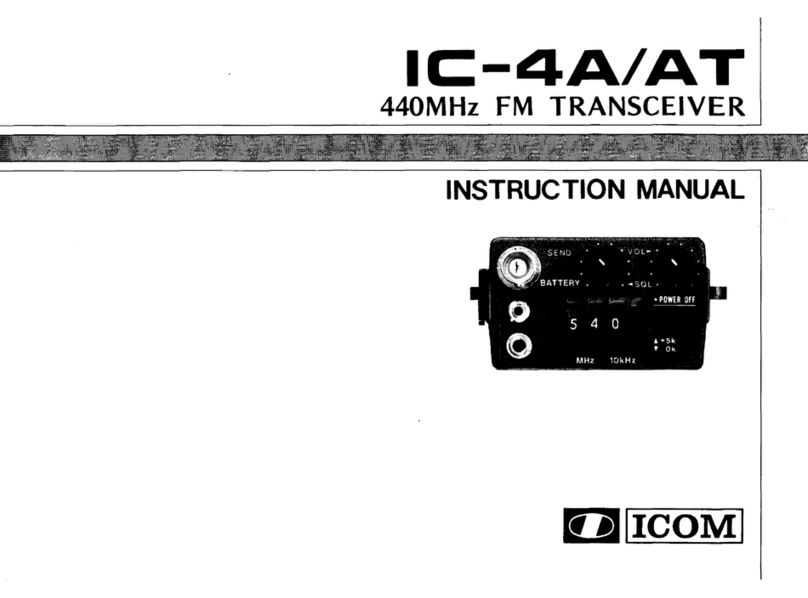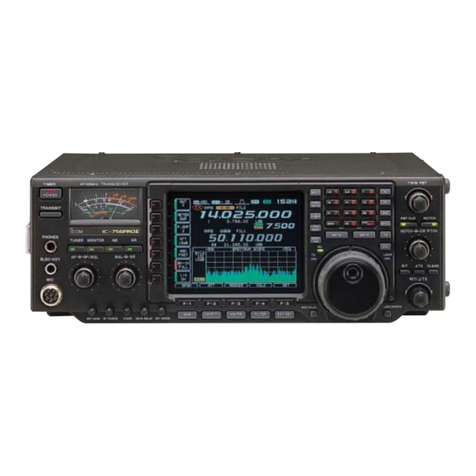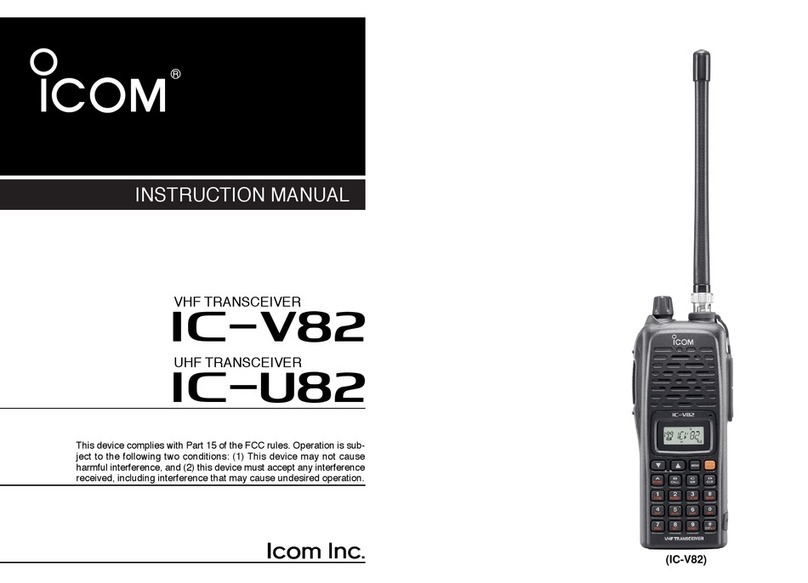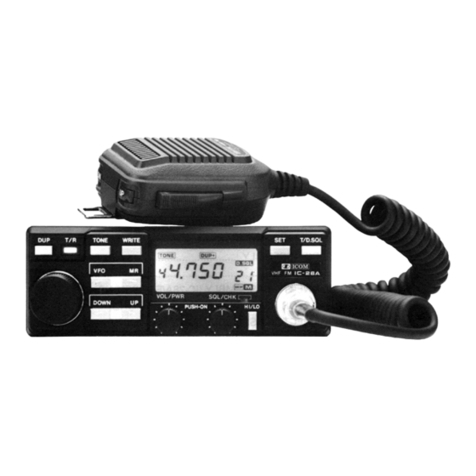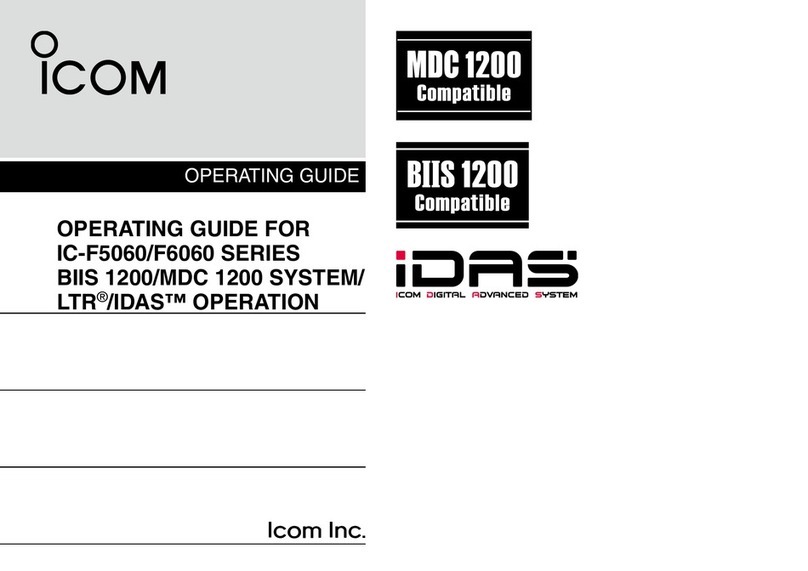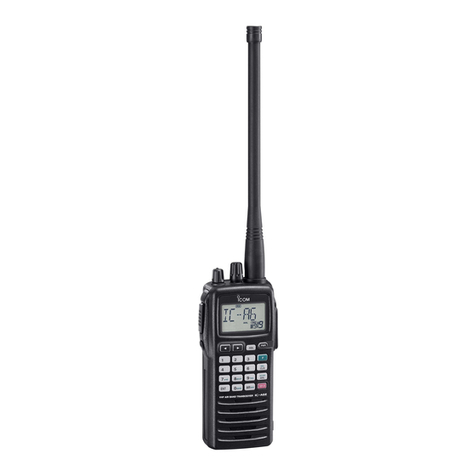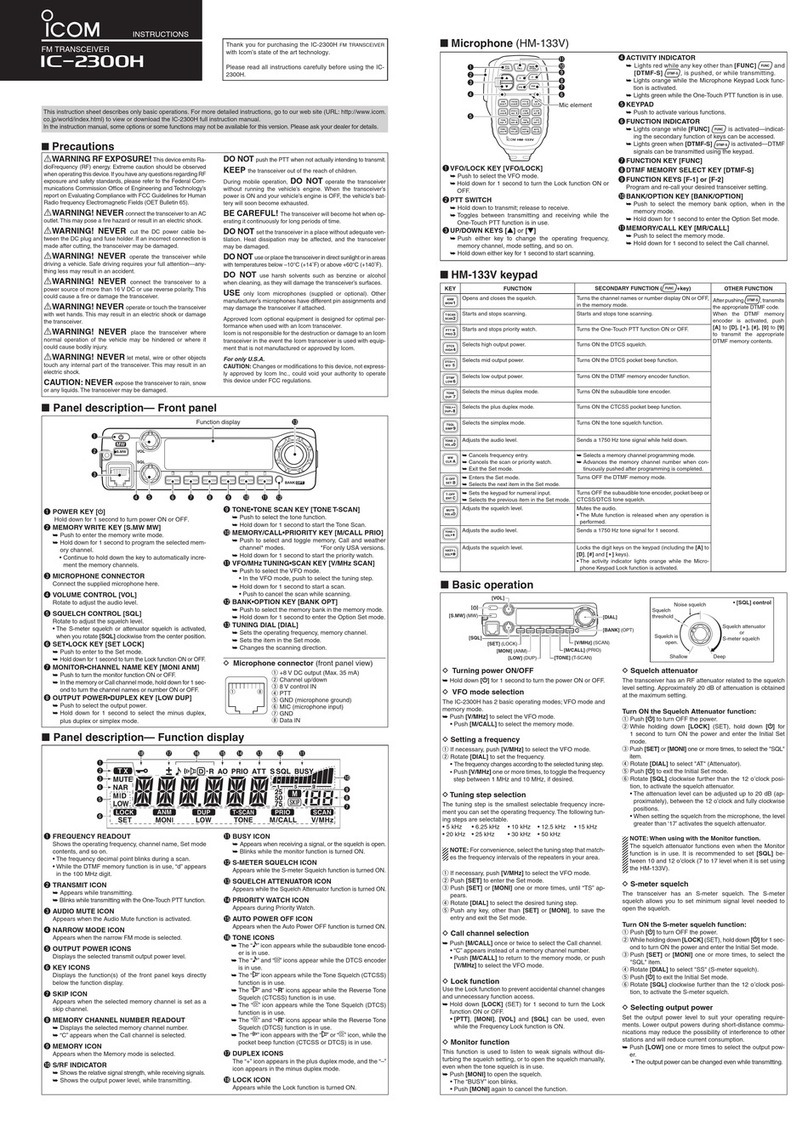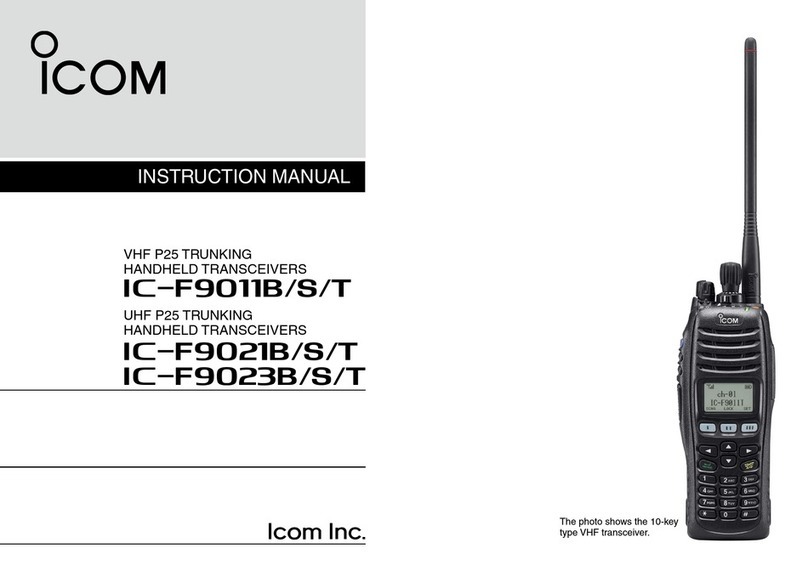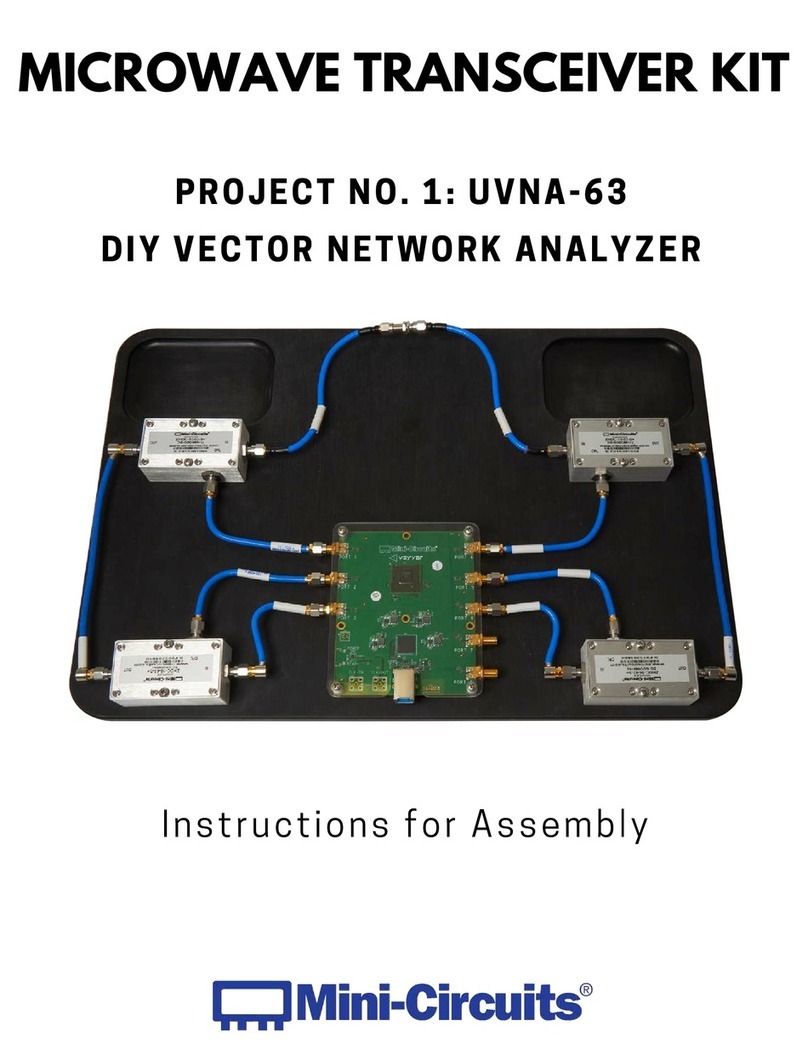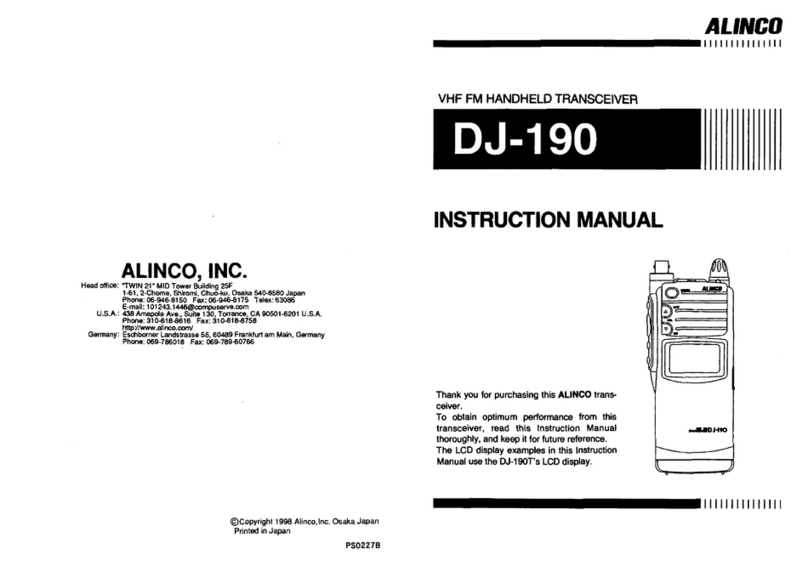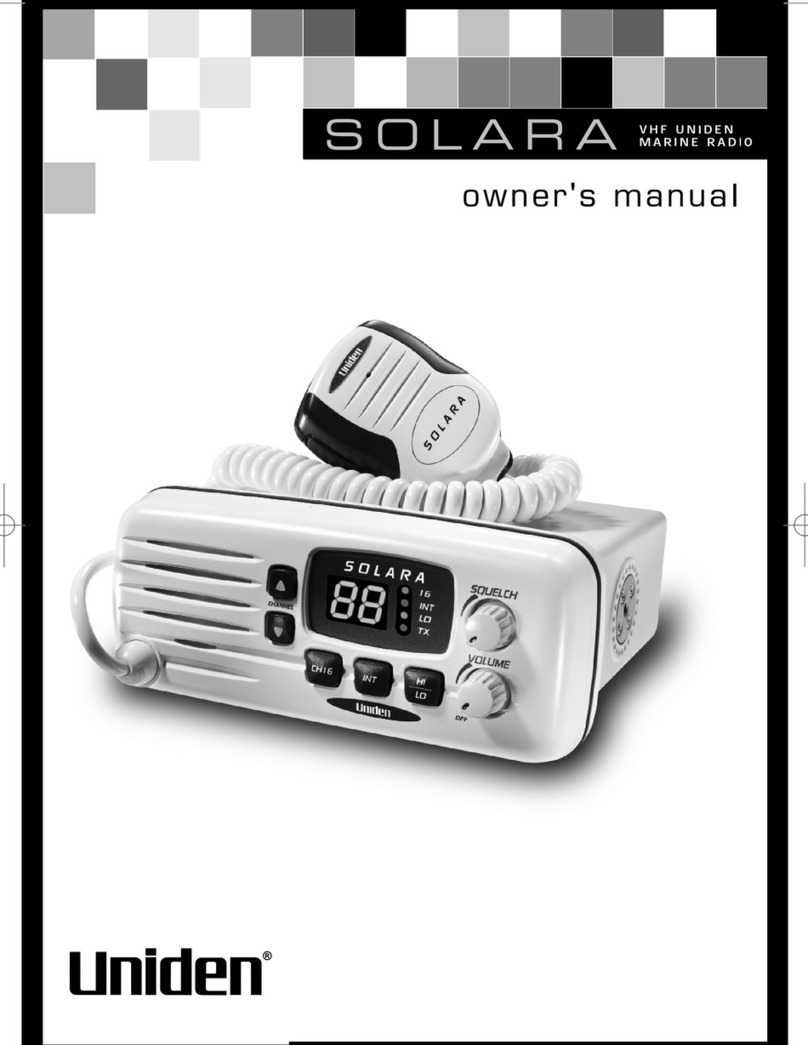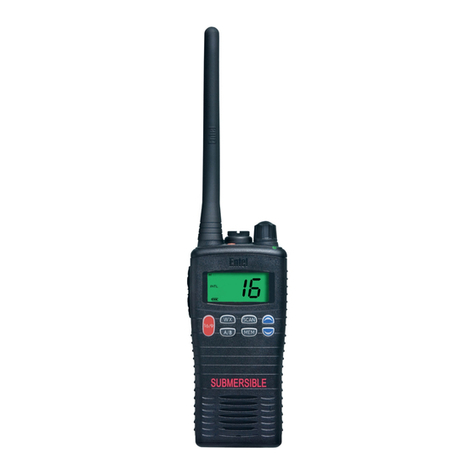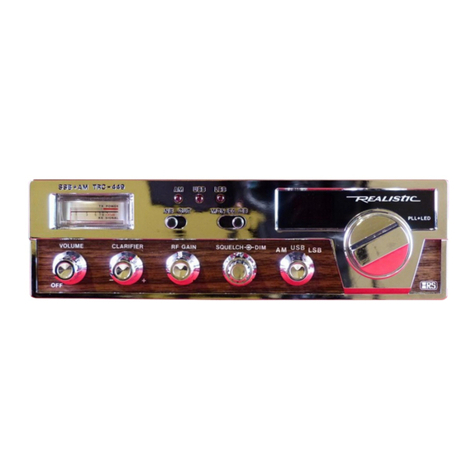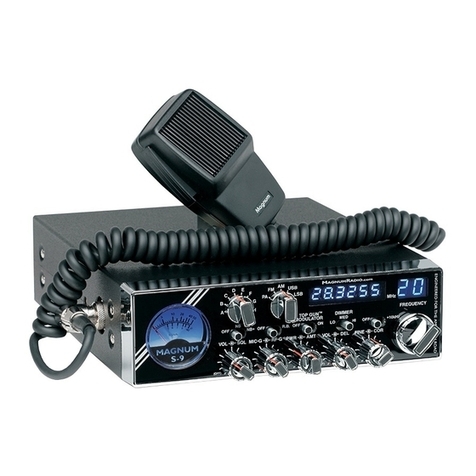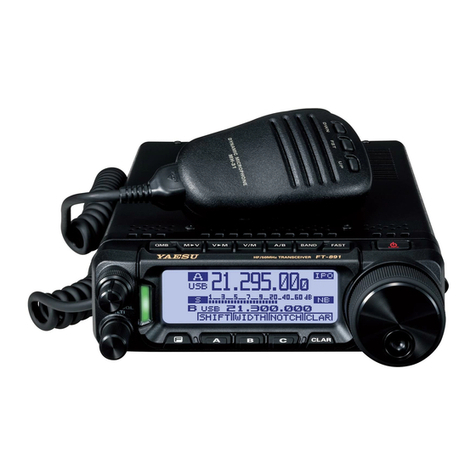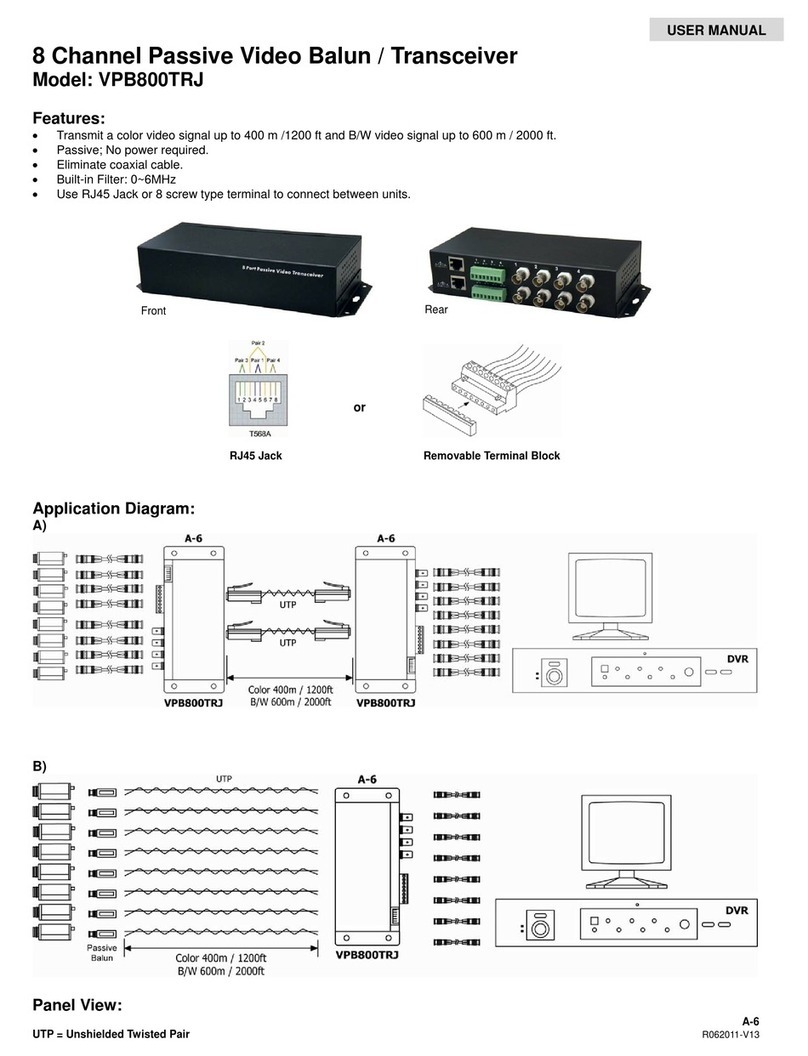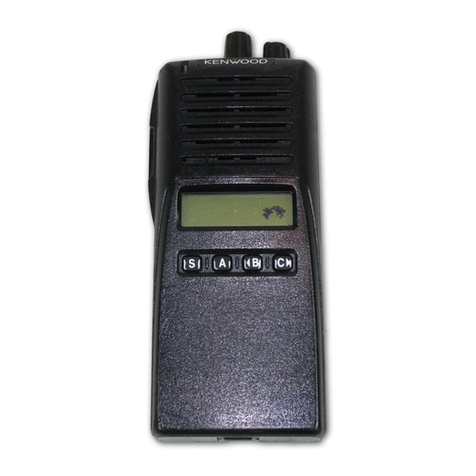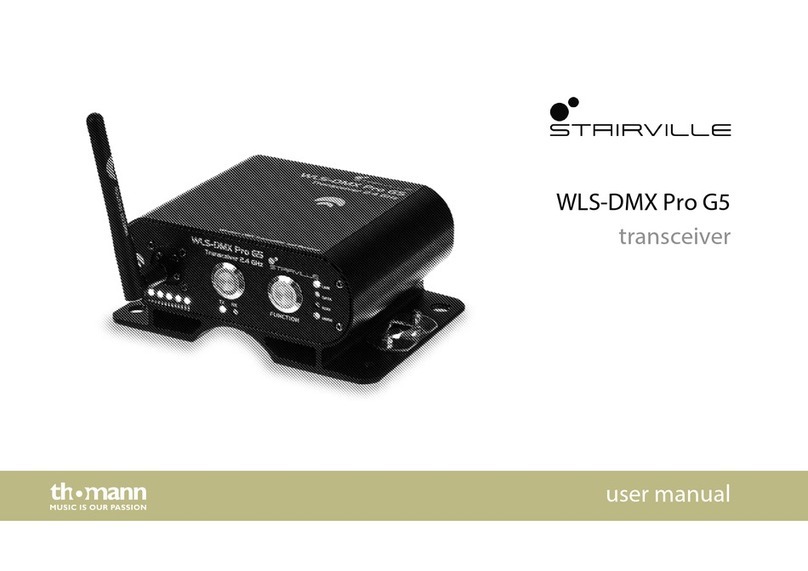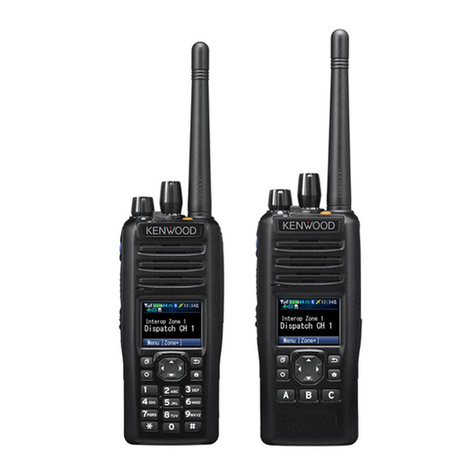Icom IC-7400 User manual

2001 NEW
HF/VHF
ALL MODE TRANSCEIVER
i7400
INSTRUCTION MANUAL
IC-7400.qxd 02.4.2 11:34 Page 1

i
2001 NEW 2001 NEW
FOREWORD
We understand that you have a choice of many differ-
ent radios in the market place. We want to take a cou-
ple of moments of your time to thank you for making
the IC-7400 your radio of choice, and hope you agree
with Icom’s philosophy of “technology first”.Many hours
of research and development went into the design of
your IC-7400.
FEATURES
• 32-bit Floating point DSP and 24-bit AD/DA converter
• DSP IF Filter creates 102 types of filter
• All mode capability covering 160–2 m
• 100 Watt continuous duty cycle
• All mode digital modulation and demodulation
• RTTY demodulator and decoder
• Twin Pass Band Tuning
• RF speech compression with selectable pass band
• Microphone Equalizer
• SSB/CW synchronous tuning
IMPORTANT
READ THIS INSTRUCTION MANUAL
CAREFULLY before attempting to operate the
transceiver.
SAVE THIS INSTRUCTION MANUAL. This
manual contains important safety and operating in-
structions for the IC-7400.
EXPLICIT DEFINITIONS
PRECAUTIONS
RWARNING HIGH VOLTAGE! NEVER attach an
antenna or internal antenna connector during transmis-
sion. This may result in an electrical shock or burn.
RNEVER apply AC to the [DC13.8V] jack on the trans-
ceiver rear panel. This could cause a fire or ruin the trans-
ceiver.
RNEVER apply more than 16 V DC, such as a 24 V
battery, to the [DC13.8V] jack on the transceiver rear
panel. This could cause a fire or ruin the transceiver.
RNEVER let metal, wire or other objects touch any in-
ternal part or connectors on the rear panel of the trans-
ceiver. This may result in an electric shock.
NEVER expose the transceiver to rain, snow or any liquids.
AVOID using or placing the transceiver in areas with tem-
peratures below –10°C (+14°F) or above +60°C (+140°F).
Be aware that temperatures on a vehicle’s dashboard can
exceed 80°C (+176°F), resulting in permanent damage to
the transceiver if left there for extended periods.
AVOID placing the transceiver in excessively dusty envi-
ronments or in direct sunlight.
AVOID placing the transceiver against walls or putting
anything on top of the transceiver. This will obstruct heat
dissipation.
Place unit in a secure place to avoid inadvertent use by
children.
During mobile operation, DO NOT operate the transceiver
without running the vehicle’s engine. When the trans-
ceiver’s power is ON and your vehicle’s engine is OFF,
the vehicle’s battery will soon become exhausted.
Make sure the transceiver power is OFF before starting
the vehicle. This will avoid possible damage to the trans-
ceiver by ignition voltage spikes.
During maritime mobile operation, keep the transceiver
and microphone as far away as possible from the magnetic
navigation compass to prevent erroneous indications.
BE CAREFUL! The heatsink will become hot when oper-
ating the transceiver continuously for long periods.
BE CAREFUL! If a linear amplifier is connected, set the
transceiver’s RF output power to less than the linear am-
plifier’s maximum input level, otherwise, the linear ampli-
fier will be damaged.
Use Icom microphones only (supplied or optional). Other
manufacturer’s microphones have different pin assign-
ments, and connection to the IC-7400 may damage the
transceiver.
WORD DEFINITION
RRWARNING Personal injury, fire hazard or electric
shock may occur.
CAUTION Equipment damage may occur.
NOTE
If disregarded, inconvenience only. No
risk or personal injury, fire or electric
shock.
IC-7400.qxd 02.4.2 11:34 Page 2

ii
SUPPLIED ACCESSORIES
The transceiver comes with the following accessories.
Qty.
qDC power cable* ................................................ 1
wHand microphone (HM-36) ................................ 1
eSpare fuses (FGB 30 A) .................................... 2
rSpare fuse (FGB 5 A) ........................................ 1
tCW keyer plug (AP-330) .................................... 1
*The illustration shows OPC-025D. However, OPC-639 is
supplied with versions, which “CE” symbol on the serial
number.
TABLE OF CONTENTS
qw
ert
FOREWORD ..................................... i
IMPORTANT ..................................... i
EXPLICIT DEFINITIONS .................. i
PRECAUTIONS ................................ i
TABLE OF CONTENTS ................... ii
QUICK REFERENCE GUIDE ..... I– X
■Installation ....................................... I
■Operation ....................................... III
■Your first contact ........................... IV
■Ready to call CQ? ......................... IX
1 PANEL DESCRIPTION ........ 1 – 12
■Front panel ..................................... 1
■Rear panel ...................................... 7
■LCD display .................................... 9
■Multi function switches .................. 11
■Microphone (HM-36) .................... 12
2 INSTALLATION AND
CONNECTIONS ................ 13 – 17
■Unpacking .................................... 13
■Selecting a location ...................... 13
■Grounding ..................................... 13
■Antenna connection ...................... 13
■Required connections ................... 14
■Advanced connections ................. 15
■Power supply connections ............ 16
■Linear amplifier connections (not
usable in European countries)....... 17
■External antenna tuner
connections .................................. 17
3 BASIC OPERATION .......... 18 – 25
■When first applying power
(CPU resetting) ............................. 18
■Initial settings ................................ 18
■Selecting an operating band ........ 19
■Selecting VFO/memory mode ...... 20
■VFO operation .............................. 20
■Frequency setting ......................... 21
■Operating mode selection ............ 23
■Volume setting .............................. 23
■Squelch and receive (RF)
sensitivity ...................................... 24
■Basic transmit operation ............... 25
4 RECEIVE AND TRANSMIT 26–45
■Operating SSB ............................. 26
■Operating CW ............................... 27
■Electronic keyer functions ............ 29
■Operating RTTY (FSK) ................. 35
■RTTY functions ............................. 36
■Operating AM ............................... 40
■Operating FM ............................... 41
■Repeater operation ....................... 44
5 FUNCTIONS FOR RECEIVE
........................................ 46 – 53
■Simple band scope ....................... 46
■Preamp/Attenuator ....................... 47
■RIT function .................................. 47
■AGC function ................................ 48
■IF filter selection ........................... 49
■IF (DSP) filter shape ..................... 50
■Noise blanker ............................... 50
■Meter peak hold function .............. 50
■Twin PBT operation ...................... 51
■Noise reduction ............................ 52
■Notch function .............................. 52
■Dial lock function .......................... 52
■Voice squelch control function ...... 53
6 FUNCTIONS FOR TRANSMIT
............................................ 54 – 60
■VOX function ................................ 54
■Break-in function .......................... 55
■∂TX function ................................ 56
■Monitor function ............................ 56
■Speech compressor ..................... 57
■Transmit filter width selection ....... 57
■Split frequency operation .............. 58
■Quick split function ....................... 59
■Measuring SWR ........................... 60
7 MEMORY OPERATION ..... 61 – 67
■Memory channels ......................... 61
■Memory channel selection ............ 61
■Programming a memory ............... 62
■Memory clearing ........................... 62
■Selecting the call channel ............. 63
■Programming the call channel ...... 63
■Frequency transferring ................. 64
■Programming scan edges ............ 65
■Assigning memory names ............ 66
■Memo pads ................................... 67
8 SCANS .............................. 68 – 73
■Scan types .................................... 68
■Preparation ................................... 68
■Voice squelch control function ...... 69
■Scan set mode ............................. 69
■Programmed scan/Fine programmed
scan .............................................. 70
■Memory scan operation ................ 71
■Select memory scan ..................... 71
■∂F scan operation and Fine ∂F scan
...................................................... 72
■Tone scan/DTCS code scan
operation ...................................... 73
9 ANTENNA TUNER OPERATION
......................................... 74–76
■Antenna connection and selection 74
■Antenna tuner operation ............... 75
■Optional external tuner operation . 76
10 DATA COMMUNICATION .. 77 – 79
■Connections ................................. 77
■Packet (AFSK) operation .............. 78
■Adjusting the TNC output level ..... 79
■Data transmission speed .............. 79
11 SET MODE ......................... 80–88
■General set mode ......................... 80
■Tone control set mode .................. 88
12 OPTION INSTALLATION .. 89 – 90
■Opening the transceiver’s case .... 89
■UT-102
VOICE SYNTHESIZER UNIT
... 89
■CR-338
HIGH STABILITY CRYSTAL UNIT
..................................................... 90
13 MAINTENANCE ................. 91–93
■Trouble shooting ........................... 91
■Fuse replacement ......................... 92
■Tuning dial brake adjustment ....... 92
■Resetting the CPU ........................ 93
■Frequency calibration (approximate)
..................................................... 93
14 CONTROL COMMAND ...... 94–98
■Remote jack (CI-V) information .... 94
15 SPECIFICATIONS ..................... 99
16 OPTIONS................................. 100
17 ABOUT CE ...................... 101–102
Icom, Icom Inc. and the logo are registered trademarks of Icom Incorporated (Japan) in the United States, the United King-
dom, Germany, France, Spain, Russia and/or other countries.
2001 NEW
IC-7400.qxd 02.4.2 11:34 Page 3

I
QUICK REFERENCE GUIDE
2001 NEW
■Installation
1. Install a ground system for DC noise suppression
and RFI suppression
2. Install your DC power supply
3. Install lightning protection. This will help protect
more than your gear.
4. Install and connect an antenna system for the ap-
propriate bands of operation
5. Connect other peripheral equipment. This includes
microphones, headsets, TNC, amplifiers and any
other equipment necessary to make your shack
complete.
Although your radio will operate by connecting the DC
power supply and antenna, it is necessary to have a
good ground system in your shack. A ground connec-
tion is the electrical contact between the common point
of an electrical or electronic system and the earth.
A good earth ground is necessary to prevent electrical
shock, eliminate problems from RFI and DC noise.
With more electronic devices being used today, it is
also important to reduce RFI and EMI. Although you
may not see interference in your shack, without a
grounding system, your neighbors may experience in-
terference. Even though many of these devices,
where they must accept interference from their sur-
rounding environment, it is best to eliminate as much
of the possible interference from your shack.
If you do not have a grounding system for your shack,
depending on the location of your shack, basement or
ground floor, a good ground system can be as simple
as a couple of ground rods driven 2 to 2.5 meter into
the soil. When installing your IC-7400 to your ground-
ing system, the shortest most direct connection is rec-
ommended.
NOTE: There are many publications covering
proper grounding techniques. Check with your local
dealer for more information and recommendations.
RWARNING!: NEVER ground station equip-
ment or antennas to house gas lines. NEVER at-
tach ground lines to plastic (pvc) pipe.
DDSome Symptoms if inadequate grounding
a. Poor DC Ground
50/60 Hz hum on the audio either Rx or Tx without
the antenna connected.
If you feel a tingling sensation when you touch a
metal surface. Surfaces such as the cover of your
radio or power supply.
b. Poor RF Ground
While transmitting and you feel a tingling sensation
when you touch a metal surface. Surfaces such as
the cover of your radio or power supply.
While transmitting, you experience interference to
other electronic devices, such as the telephone,
television or stereo audio systems.
The DC power supply is a device used to convert
110/220 V AC, also know as Household current, to a
steady source of 13.8 V DC.
The perfect match to your IC-7400 is the PS-125. This
compact switching power supply is the matching
power supply for your IC-7400 with a current rating of
25 A continuous duty. This plug and play unit plugs
into the DC jack located on the rear of the radio.
• If you are not using the PS-125:
Connect the supplied DC power cable to the appro-
priate color coded terminals, then insert the DC con-
nector into the DC jack located on the rear of the
radio. (The diagram below describes the connection with
OPC-639. OPC-025D has no filter box and GND cable.)
NOTE: Although the power supply current require-
ment is quite low during receiving, this not the case
when you transmit. With many electrical devices in
the shack, it is very important to verify the electrical
circuit is not overloaded.
30 A fuses
AC cable
Transceiver
AC
outlet
A DC power
supply*
*13.8 V; at least 23 A
continuous
Black
_
Red
+
to DC power
socket
Supplied
DC power cable
PS-125 DC power
socket
Transceiver
DC power cable
Connect to an AC outlet using the supplied AC cable.
1. Grounding your Shack
2. Installing your DC Power Supply
IC-7400.qxd 02.4.2 11:35 Page I

II
QUICK REFERENCE GUIDE
3. Installing lightning protection
Although you may not live in an area with high occur-
rence for lightning storms, it is always wise to take
precautions for lightning or static discharges. Proper
lightning protection not only offers protection to the
ham gear, but the shack and most importantly the op-
erator.
NOTE: There are many publications covering
proper lightning protection, check with your local
dealer for more information and recommendations.
Whether your IC-7400 is your first radio or one of
many, one of your key elements in a great shack is
the antenna system. There are three connections on
the back of your IC-7400, two for HF and 6 m and one
for 2 m. If you are using one antenna for HF and 6 m,
for simplicity, connect the antenna coax to ANT 1.
Your IC-7400 is equipped with an internal antenna
tuner (ATU) for operation on 160–6 m. This ATU is de-
signed to work with an unbalanced 50 Ωfeedline. The
purpose of the internal antenna tuner is to match the
impedance of your antenna system to as close to a
50 Ωload as possible. This ATU will not operate with
a long wire or ladder line (450 Ωor other balanced
feedlines). An external ATU such as the AH-4 would
be necessary for this kind of operation.
PL-259 CONNECTOR INSTALLATION EXAMPLE
30 mm ≈9⁄8in 10 mm ≈3⁄8in 1–2 mm ≈1⁄16 in
RWARNING: Although a mag mount antenna
works great on a vehicle, DO NOT use the IC-7400
with this type of antenna.
CAUTION: Although your IC-7400 has protection
to drop down power with a high SWR, this does not
completely protect the transceiver from transmis-
sion without an antenna. Make sure you have an
antenna connected whenever you transmit with
your radio.
NOTE: There are many publications covering
proper antennas and their installation, check with
your local dealer for more information and recom-
mendations.
30 mm
10 mm (soft solder)
10 mm
1–2 mm
solder solder
Soft
solder
Coupling ring
Slide the coupling ring
down. Strip the cable
jacket and soft solder.
Slide the connector
body on and solder it.
Screw the coupling
ring onto the
connector body.
Strip the cable as
shown at left. Soft sol-
der the center con-
ductor.
q
w
e
r
Antenna SWR
Each antenna is tuned for a specified frequency
range and SWR may be increased out-of-range.
When the SWR is higher than approx. 2.0:1, the
transceiver’s power drops to protect the final tran-
sistors. In this case, an antenna tuner is useful to
match the transceiver and antenna. Low SWR al-
lows full power for transmitting even when using the
antenna tuner. The IC-7400 has an SWR meter to
monitor the antenna SWR continuously.
ANTENNA 1, 2
[Example]: ANT1 for 1.8–18 MHz bands
ANT2 for 21–50 MHz bands
144 MHz ANTENNA
Connect a VHF (60–144 MHz)
antenna; impedance: 50 Ω.
4. Installing your antenna system
IC-7400.qxd 02.4.2 11:35 Page II

III
QUICK REFERENCE GUIDE
2001 NEW 2001 NEW
5. Connect other peripheral equipment
Everyone has his or her favorite ad-on gear; now is
the time to connect this gear! We will cover the basic
devices that can be connected to your IC-7400.
If you do not see the particular item you are wanting
to connect, refer to the Advance Connections section
starting on page 15.
Microphones: Connect the microphone to the eight-
pin connector on the front of the radio.
MICROPHONES
HM-36 SM-20
■Operation
1. Voice
CW Key: There are several types of keys or keyers
that can be used with your IC-7400.
a. Iambic Key paddle: Use a 6.35(d) mm (1⁄4″) stereo
plug and connect to the [ELEC-KEY] jack located
on the front of the radio.
b. Straight Key: Use a 6.35(d) mm (1⁄4″) mono plug
and connect key to the back of the radio.
c. External Keyer: Use a 6.35(d) mm (1⁄4″) mono
plug and connect to the back of the radio.
d. Computer Keying: Use a 6.35(d) mm (1⁄4″) mono
plug and connect to the back of the radio.
NOTE: You will need to select the type of keyer you
are using in the Keyer Set mode. There are many
advanced CW functions in this set mode, until you
have a full understanding of these functions
change only the items necessary.
STRAIGHT KEY
(+)
(_)
CW KEY
A straight key can be used when the internal
electronic keyer is turned OFF in keyer set
mode. (p. 34)
(dot)
(com)
(dash)
2. CW
IC-7400.qxd 02.4.2 11:35 Page III

IV
QUICK REFERENCE GUIDE
2001 NEW
3. Other convenient items
Headphones:
A 6.35(d) mm (1⁄4″) mono jack for operation without
using the internal or external speakers. Perfect for op-
eration without disturbing others in the room.
External Speaker:
A 3.5(d) mm (1⁄8″) mono jack for operation with an ex-
ternal speaker. (Input impedance: 8 Ω/Max. input
power: 5 W)
EXTERNAL SPEAKER
SP-21 (optional)
HEADPHONES
1. Before powering up your radio, you may want to
make sure the following controls are set in the fol-
lowing positions:
•[AF] : Commonly referred to as the vol-
ume: fully counter clockwise.
•[NR] : The noise reduction control: fully
counter clockwise.
•[MIC GAIN] : The mic gain: fully counter clock-
wise.
•[RF/SQL] : The control for the RF Gain and
Squelch circuits: 12 o’clock.
•[CW PITCH] : The control for the CW pitch:
12 o’clock.
•[KEY SPEED] : Internal CW Keyer Speed: fully
counter clockwise.
•[NOTCH] : Control for the manual notch:
12 o’clock
2. Resetting the CPU: Although you have purchased
a brand new radio, some settings may be changed
from the factory defaults during the QC process. So
your radio can start from Factory Defaults resetting
the CPU is necessary.
[POWER] [F-INP] [M-CL]
■Your first contact
Now you should have your IC-7400 installed in your
shack, and like a kid on his birthday, you are probably
excited to get on the air. We would like to take you
through a few basic operation steps to make your first
“On The Air”an enjoyable experience.
DDGetting started
IC-7400.qxd 02.4.2 11:35 Page IV

V
QUICK REFERENCE GUIDE
2001 NEW 2001 NEW
DDJust listening
3. Verify proper antenna has been selected.
1. Select the desired band
On your IC-7400, an easy way of changing bands is
by using the keypad located just above the tuning
knob on the right hand side of the display. You will no-
tice each switch has two sets of numbers; one set of
numbers represents the band selection.
•Say you want to go to 20 meters or 14 MHz; you
would push the [14
5
]. This will immediately change
the displayed operating frequency to the 20-meter
band. By pushing [14
5
] again, frequency pre-sets
in the triple band stacking registers frequency can be
displayed. For more details on this system refer to
p. 19.
GENE
50
0
21
7
24
8
28
9
14
5
10
4
18
6
3.5
2
1. 8
1
7
3
144
ENT
Directly below the keypad is the tuning knob. This will
allow you to dial in the frequency you want to oper-
ate. You will notice the tuning speed [TS] is 10 Hz res-
olution. Page 22 will instruct you on how to set the
tuning speed [TS] for 1 Hz resolution.
NOTE: Although you can directly enter the fre-
quency with the keypad, using the Band Stacking
Register and the tuning knob is the most popular
method of hoping around the bands. For more in-
formation regarding the direct frequency entry
method, refer to p. 22.
Your IC-7400 has three antenna connectors. Two for
HF and 6 m and a one for 2 m. The selection for 2 m
is automatic, where the HF and 6 m is user selectable
for either one of the antenna jacks. For first time use,
the antenna selector should show “”on the dis-
play of your radio. Verify the antenna selected on the
display is the antenna port your antenna is connected
to.
Either “1”or “2”appears.
*No indicator appears during
144 MHz operation.
Adjust this control to a comfortable audio level.
AF RF/SQL
No audio output Max. audio output
Decreases Increases
2. Tune to the desired frequency
4. Adjust audio output
IC-7400.qxd 02.4.2 11:35 Page V

VI
QUICK REFERENCE GUIDE
2001 NEW
DDWhat are you hearing?
Stop and focus on what you are hearing. Do you hear
a lot of noise? Is the signal intelligible? Are you set up
for the right mode? How about the filters?
1. Verify mode
Your IC-7400 has many features to reduce QRM and
QRN from the desired signal.
a. Noise Reduction: The noise reduction system on
your IC-7400 is part of the 32-bit DSP. This is used
to reduce the hiss and QRM levels. To activate,
push the [NR] switch located just to the right of the
[PHONES] jack.
b. Adjusting the Noise Reduction: The noise re-
duction is completely variable on how much of the
DSP Noise Reduction is used [NR] level control lo-
cated just above the [NR] switch.
Hint!
How far you advance the NR control will determine
how much the noise can be effectively reduced.
Turning the control too far clockwise may cause
some distortion to occur on the received signal. The
NR control should only be turned as far clockwise
as is necessary. Use this control, along with RF
gain, NB (noise blanker, if needed), and IF filters as
well, to minimize the effects of noise on the target
signal.
Noise reduction ON
Noise reduction OFF
NR NOTCH
OFF
Decreases Increases
AGC
DUP
CMP
TBW
SCP
[NR] [NR]
Appears
Although your IC-7400 will automatically select USB
or LSB in the HF bands, it will not select any of the
other modes. You will need to select the proper mode
whether CW, RTTY, AM or FM. Hint!
The Triple Band Stacking Register will memorize
the last three frequencies used in the band, as well
as the Mode, Filter, Tuner and AGC settings. This
makes band hoping much easier.
SSB
CW/RTTY
AM/FM
2. Reducing interference
IC-7400.qxd 02.4.2 11:35 Page VI

VII
QUICK REFERENCE GUIDE
2001 NEW 2001 NEW
c. Notch: There are two notch systems on your IC-
746PRO.
•Automatic: The automatic notch will track up to three
heterodynes. This is helpful for eliminating annoying
transmitter “tune up”tones on any band, and to min-
imize continuous tone “heterodynes”encountered on
the 40 meter phone bands at night, for example.
Once selected an icon will appear “ANOTCH”on
the display.
•Manual: The Manual notch provides 70 dB of atten-
uation to pin point an interfering signal. The 12 o’-
clock position is on the operating frequency, turning
the Notch knob clockwise moves the notch up the
band and counter clockwise will move the notch
down the band. Once selected an icon “NOTCH”will
appear on the display.
NOTE: Your IC-7400 is equipped with multiple
AGC circuits. This allows the DSP to filter out inter-
fering signals and QRM, while also taking this in-
terference out of the AGC. Bottom line, this will ei-
ther eliminate or greatly reduce the pumping of the
AGC from the interfering signal.
AGC
DUP
CMP
TBW
SCP
[A/NOTCH] [NOTCH]
Notch function indicators
NR NOTCH
Low frequency High frequency
Hint!
The Automatic Notch will not operate in the SSB
data, CW or RTTY modes.
d. Filters: Your IC-7400 has an incredible IF DSP
based filter network with over 100 settings.
•Dial in your filters: By pushing [FILTER] for 1 sec.,
you enter the filter set mode. This is where you are
able set the three filter presets. Across the bottom of
the display you will see the “BW”icon. The switch di-
rectly below, along with the tuning dial, will be used
to select the changes you will make.
BW
•Filter set mode indication
Shows the selected filter and passband width.
BW
•Indication while setting
While pushing [F1 BW], rotate the tuning dial to set
passband width.
Reverses Appears
AGC
DUP
CMP
TBW
SCP
[FILTER]
The selected filter width is indicated
for approx. 1 sec. when [FILTER] is
pushed. Filter selection
IC-7400.qxd 02.4.2 11:35 Page VII

VIII
QUICK REFERENCE GUIDE
2001 NEW
d. Filters:—continued
•
On the fly adjustment: Once the adjustments have
been made in the filter set mode, you can make on
the fly changes by using the Twin Pass Band Tuning,
Twin PBT. You will be able to see the effects of the
Twin PBT on the upper left hand side of the screen.
NOTE: The Twin PBT filters shift the two IF DSP
filters (See Diagrams below and right). This feature
allows both an IF shift as well as a narrowing of the
Pass Band. Although you can narrow the pass
band by shifting the two filters, this does not nar-
row both filters, thus the filter shape is not nar-
rowed. You may hear some signal artifacts pass
through this filter adjustment.
PBT operation example
BW
•Filter set mode indication
Shows the selected filter and passband width.
BW
•Indication while PBT setting
Appears when passband is shifted.
*By pushing [PBTC] for 1 sec., the shifted value returns
to the default setting, and the “dot”disappears.
AGC
DUP
CMP
TBW
SCP
Passband width and shifting value are
indicated while [TWIN PBT] is operated.
[TWIN PBT] control
[PBTC]
Appears when PBT is used.
One of “1,”“2”or “3”is
displayed for selected filter
number indications.
interference
inteference
interference desired signal
desired signal
pass band
IF center frequency
Center Passband Passband
IF center freq.
IF shift
IC-7400.qxd 02.4.2 11:35 Page VIII

IX
QUICK REFERENCE GUIDE
2001 NEW 2001 NEW
Once you have mastered your filter settings, one last
feature to enable the most intelligible audio is the ac-
tual audio tone you hear. You can adjust the equal-
ization of your received audio ±5dB.
qPush [MENU] several times, or until M2 is shown
on the display.
wPush [F4 TCN] for the Tone Control set mode.
ePush the appropriate mode switch to adjust SSB,
AM or FM.
rPush [F1 ≤] or [F2 ≥] to change to the desired
component.
[F1 ≤]
Tuning dial[MENU]
[F2 ≥] [F4 TCN]
3. RX Tone Control:
1. RX Bass
This item adjusts the bass level of the receive audio
tone from –5 dB to +5 dB in 1 dB steps.
RX
Bass
SSB
O
3
2. RX Treble
This item adjusts the treble level of the receive audio
tone from –5 dB to +5 dB in 1 dB steps.
RX
Treble
SSB
O
4
We hope these pointers have been helpful. Now you
are ready for the “Ready to call CQ?”.
■Ready to call CQ?
The 32-bit DSP in your IC-7400 is capable of allowing
you to selects transmit audio for phone modes.
POWER
TRANSMIT
PHONES
ELEC-KEY
MIC
NR
A/NOTCH
TUNER
ANT
HF/VHF TRANSCEIVER
NR
NOTCH
AF
MIC GAIN
RF PWR
CW PITCH
F 1
F
2F
3
F
4
F
5
XFC
MP-W
GENE
50
0
21
7
24
8
28
9
14
5
10
4
18
6
3.5
2
1. 8
1
7
3
144
ENT
MP-R
TX RX
LOCK
TWIN PBT
M-CH
RIT
CLEAR
∂TX
RIT/∂TX
TS
SPLIT
PBTC
F-INP
A/B
V/M
MW
M-CL
KEY SPEED
P.AMP/ATT
NB
VOX/BK-IN
MONITOR
CALL
LOCK/
SPCH
RF/SQL
i7400
MENU SSB
CW/RTTY
AM/FM
FILTER
[NR]: Max. CCW [NOTCH]: Max. CCW
[AF]: Max. CCW
[TRANSMIT]: OFF
[MIC GAIN]: Max. CCW
[RF PWR]: Max. CCW [CW PITCH]: 12 o’clock
[RF/SQL]: 12 o’clock
[KEY SPEED]: Max. CCW
1. Setting up your transmit audio
2. Mic Gain
The microphone gain is used for proper transmit
audio level for full output power.
IC-7400.qxd 02.4.2 11:35 Page IX

X
QUICK REFERENCE GUIDE
2001 NEW
Verify you have selected a clear frequency
and call out your CQ!
The capability of changing the pass band of your
transmit audio, is at your finger tips. Regardless of the
condition of the speech compressor, you can adjust it
by selecting the [F4 TBW].
You will find this located in the M1 menu. By pushing
[F4 TBW] for 1 sec. you can select the TX audio band
pass.
There are three levels of audio passband width avail-
able (Wide, Mid, and Nar).
TX Audio Passband widths
Wide : 2.8 kHz ; Great Full Audio
Mid : 2.4 kHz ; Great for operators with
deep full voices
Nar : 2.2 kHz ; Great for breaking through
pile ups
F 1
F
2F
3
F
4
F
5
F 1 F 2 F 3 F 4 F 5
AGC
DUP
CMP
TBW
SCP
AGC
DUP
CMP
TBW
SCP
TX
BW=WIDE
Push [F4]
Push [F4] for 1 sec. to select the transmit filter width.
The selected transmit filter width
is displayed for approx. 1 sec.
3. DSP TX Audio Pass Band
4. Microphone Equalizer
Although these bandwidths are fixed, the Microphone
Tone Control will give you more audio control for your
voice operation on SSB, AM, and FM modes. Your IC-
7400 is equipped with a very powerful equalizer sys-
tem with 121 possible combinations. This is achieved
by using the separate bass and treble adjustments.
The default for both the Base and Treble is at 0 dB.
Entering Microphone Tone Control set mode:
qPush [MENU] several times, or until M2 is shown
on the display.
wPush [F4 TCN] for the Tone Control set mode.
ePush the appropriate mode switch to adjust SSB,
AM, or FM.
rPush [F1 ≤] or [F2 ≥] to change to the desired
component.
Hint!
Voice patterns and audio characteristics vary with
each operator, therefore the [MIC GAIN], DSP TX
Audio Pass Band and Microphone Tone Control
settings will be different for each operator. Actual on
air experimenting is necessary to get just the right
sound. Listen to your transmit audio with head-
phones and the monitor function turned ON. It’s
also best to test and adjust your audio on the air,
while someone who knows what your real voice
sounds like listens, and provides and opinion on
your audio quality.
[F1 ≤]
Tuning dial[MENU]
[F2 ≥] [F4 TCN]
1. TX Bass
This item adjusts the bass level of the transmit audio
tone from –5 dB to +5 dB in 1 dB steps.
TX
Bass
SSB
O
1
2. TX Treble
This item adjusts the treble level of the transmit audio
tone from –5 dB to +5 dB in 1 dB steps.
TX
Treble
SSB
O
2
IC-7400.qxd 02.4.2 11:35 Page X

1
1
PANEL DESCRIPTION
2001 NEW
■Front panel
qPOWER SWITCH [POWER]
➥Push momentarily to turn power ON.
•Turn the optional DC power supply ON in advance.
➥Push for 1 sec. to turn power OFF.
wTRANSMIT SWITCH [TRANSMIT]
Selects transmitting or receiving.
•The [TX] indicator lights red while transmitting and the
[RX] indicator lights green when the squelch is open.
eHEADPHONE JACK [PHONES]
Accepts headphones.
•Output power: 5 mW with an 8 Ωload.
•When headphones are connected, the internal speaker
or connected external speaker does not function.
rELECTRONIC KEYER JACK [ELEC-KEY] (p. 14)
Accepts a paddle to activate the internal electronic
keyer for CW operation.
•Selection between the internal electronic keyer, bug-key
and straight key operation can be made in keyer set
mode. (p. 34)
•A straight key jack is separately available on the rear
panel. See [KEY] on p. 7.
•Keyer polarity (dot and dash) can be reversed in keyer
set mode. (p. 34)
•4-channel memory keyer is available for your conve-
nience. (p. 30)
tMICROPHONE CONNECTOR [MIC]
Accepts the supplied or an optional microphone.
•See p. 101 for appropriate microphones.
•See p. 12 for microphone connector information.
yRF GAIN CONTROL/SQUELCH CONTROL
[RF/SQL] (outer control)
Adjusts the RF gain and squelch threshold level.
The squelch removes noise output from the speaker
(closed condition) when no signal is received.
•The squelch is particularly effective for FM. It is also
available for other modes.
•12 to 1 o’clock position is recommended for any setting
of the [RF/SQL] control.
•The control can be set as ‘Auto’(RF gain control in SSB,
CW and RTTY; squelch control in AM and FM) or
squelch control (RF gain is fixed at maximum) in set
mode as follows. (p. 81)
•When setting as RF gain/squelch control
Recommended level
RF gain
adjustable
range
Maximum
RF gain
S-meter
squelch
Noise squelch (FM mode)
Squelch is
open.
MODE
SSB, CW
RTTY
AM, FM
AUTO
RF GAIN
SQL
SQL
SET MODE SETTING
SQL
SQL
RF GAIN + SQL
RF GAIN + SQL
RF GAIN + SQL
(dot)
(com)
(dash)
POWER
TRANSMIT
PHONES
ELEC-KEY
MIC
NR
A/NOTCH
TUNER
ANT
HF/VHF TRANSCEIVER
NR
NOTCH
AF
MIC GAIN
RF PWR
CW PITCH
F 1
F
2F
3
F
4
F
5
XFC
MP-W
GENE
50
0
21
7
24
8
28
9
14
5
10
4
18
6
3.5
2
1. 8
1
7
3
144
ENT
MP-R
TX RX
LOCK
TS
SPLIT
F-INP
A/B
KEY SPEED
P.AMP/ATT
NB
VOX/BK-IN
MONITOR
CALL
LOCK/
SPCH
RF/SQL
i7400
MENU SSB
CW/RTTY
AM/FM
FILTER
q
w
e
r
t
yuio !0 !1
!4!5!6!7 !3 !2
IC-7400.qxd 02.4.2 11:35 Page 1

2
1
PANEL DESCRIPTION
•When functioning as RF gain control
(Squelch is fixed open; SSB, CW, RTTY only)
•When functioning as squelch control
(RF gain is fixed at maximum.)
While rotating the RF gain control, noise may be
heard. This comes from the DSP unit and does not
indicate an equipment malfunction.
uMIC GAIN CONTROL [MIC GAIN]
Adjusts microphone input gain.
•The transmit audio tone in SSB, AM and FM modes can
be adjusted in tone control set mode. (p. 88)
✔
How to set the microphone gain.
Set the [MIC] control so that the ALC meter sometimes
swings during normal voice transmission in SSB mode.
Make sure that voice peak readings do not exceed the ALC
range brackets on the meter.
iAF CONTROL [AF] (inner control)
Varies the audio output level from the speaker.
oRF POWER CONTROL [RF PWR]
Continuously varies the RF output power from min-
imum (less than 5 W*) to maximum (100 W*).
* AM mode: less than 5 W to 40 W
!0 CW PITCH CONTROL [CW PITCH] (p. 28)
Shifts the received CW audio pitch and monitored
CW audio pitch without changing the operating fre-
quency.
•The pitch can be changed from 300 to 900 Hz in approx.
25 Hz steps.
!1 ELECTRONIC CW KEYER SPEED CONTROL
[KEY SPEED] (p. 28)
Adjusts the internal electronic CW keyer’s speed.
•6 wpm (min.) to 60 wpm (max.) can be set.
!2 AUTO NOTCH/MANUAL NOTCH SWITCH
[A/NOTCH] (p. 52)
Toggles the notch function between manual and au-
tomatic when pushed.
•“NOTCH”appears when manual; “ANOTCH”appears
when automatic notch is selected.
!3 NOTCH CONTROL [NOTCH] (outer control; p. 52)
Adjusts the notch filter frequency to remove an in-
terfering signal.
!4 ANTENNA SELECTOR SWITCH [ANT] (p. 74)
Switches the antenna connector selection between
ANT1 and ANT2 when pushed.
!5 NOISE REDUCTION LEVEL CONTROL [NR]
(inner control; p. 52)
Adjusts the noise reduction level when the noise re-
duction is in use. Set for maximum readability.
!6
ANTENNA TUNER SWITCH [TUNER] (pgs. 75, 76)
➥Turns the antenna tuner ON and OFF (bypass)
when pushed momentarily.
➥Starts to tune the antenna manually when
pushed for 1 sec.
•When the tuner cannot tune the antenna, the tuning
circuit is bypassed automatically after 20 sec.
!7 NOISE REDUCTION SWITCH [NR] (p. 52)
Switches the noise reduction ON and OFF.
•“NR”appears while the noise reduction is activated.
NR NOTCH
OFF
Decreases Increases
NR NOTCH
Low frequency High frequency
Slow Fast
KEY SPEED
CW PITCH
IncreasesDecreases
RF PWR
IncreasesDecreases
AF RF/SQL
No audio output Max. audio output
Decreases Increases
MIC GAIN
Recommended level for
an Icom microphone
IncreasesDecreases
Squelch is
open.
S-meter
squelch
S-meter squelch
threshold
Noise squelch
threshold
(FM mode)
Shallow Deep
Noise squelch (FM mode)
Minimum RF gain
Adjustable
range
Maximum
RF gain
IC-7400.qxd 02.4.2 11:35 Page 2

3
1PANEL DESCRIPTION
2001 NEW 2001 NEW
■Front panel (continued)
!8 MULTI-FUNCTION SWITCHES [F1]–[F5]
➥Push to select the function indicated in the LCD
display above these switches. (p. 11)
•Functions vary depending on the operating mode.
➥Push to input a character for memory keyer pro-
gramming or memory name. (pgs. 31, 66)
!9 MENU SWITCH [MENU]
Push to change the set of functions assigned to the
multi-function switches.
•Toggles between menu 1 (M1) and menu 2 (M2).
@0 MODE SWITCHES
Selects the desired mode. (p. 23)
•Announces the selected mode when an optional UT-102
is installed. (p. 89)
➥Selects USB and LSB mode alternately.
➥Selects SSB data mode (USB-D, LSB-D)
when pushed for 1 sec. in SSB mode.
➥Selects CW and RTTY mode alternately.
➥Switches CW and CW-R (CW reverse)
mode when pushed for 1 sec. in CW
mode.
➥Switches RTTY and RTTY-R (RTTY re-
verse) mode when pushed for 1 sec. in
RTTY mode.
➥Selects AM and FM mode alternately.
➥Selects AM/FM data mode (AM-D, FM-D)
when pushed for 1 sec. in AM/FM mode.
@1 PREAMP/ATTENUATOR SWITCH [P.AMP/ATT]
(p. 47)
➥Push momentarily to toggle between preamp-1
and preamp-2.
•“P.AMP1”activates for HF all bands.
•“P.AMP2”activates high-gain preamp for 24 MHz
band and above.
➥Push for 1 sec. to toggle the attenuator function
ON and OFF.
✔
What is the preamp?
The preamp amplifies received signals in the front end cir-
cuit to improve the S/N ratio and sensitivity. Select “P.AMP1”
or “P.AMP2”when receiving weak signals.
✔
What is the attenuator?
The attenuator prevents a desired signal from distorting
when very strong signals are near the desired frequency, or
when very strong electric fields, such as from a broadcast-
ing station, are near your location.
@2 NOISE BLANKER SWITCH [NB] (p. 50)
➥Switches the noise blanker ON and OFF when
pushed. The noise blanker reduces pulse-type
noise such as that generated by automobile igni-
tion systems. This function cannot be used for
FM, or non-pulse-type noise.
•“NB”appears while the noise blanker is activated.
➥Enters the noise blanker level set mode when
pushed for 1 sec.
AM/FM
CW/RTTY
SSB
T
Y
NR
A/NOTCH
TUNER
ANT
HF/VHF TRANSCEIVER
NR
NOTCH
AF
MIC GAIN
RF PWR
CW PITCH
F 1
F
2F
3
F
4
F
5
XFC
MP-W
GENE
50
0
21
7
24
8
28
9
14
5
10
4
18
6
3.5
2
1. 8
1
7
3
144
ENT
MP-R
TX RX
LOCK
TWIN PBT
M-CH
RIT
CLEAR
∂TX
RIT/∂TX
TS
SPLIT
PBTC
F-INP
A/B
V/M
MW
M-CL
KEY SPEED
P.AMP/ATT
NB
VOX/BK-IN
MONITOR
CALL
LOCK/
SPCH
RF/SQL
i746PRO
MENU SSB
CW/RTTY
AM/FM
FILTER
#7
#6
#5
#4
#3
#2
#1
#0
!9 @0 @1!8 @2 @3 @4 @6@5 @7 @8 @9
IC-7400.qxd 02.4.2 11:35 Page 3

4
1
PANEL DESCRIPTION
2001 NEW
@3 VOX/BREAK-IN SWITCH [VOX/BK-IN]
➥In SSB, AM and FM modes, push momentarily to
turn the VOX function ON and OFF (p. 54); push
for 1 sec. to enter VOX set mode (p. 54).
➥In CW mode, push momentarily to turn the semi
break-in, full break-in or break-in OFF (p. 55);
push for 1 sec. to enter break-in set mode (p. 55).
✔
What is the VOX function?
The VOX function (voice operated transmission) starts trans-
mission without pushing the transmit switch or PTT switch
when you speak into the microphone; then, automatically re-
turns to receive when you stop speaking.
✔
What is the break-in function?
Full break-in (QSK) activates the receiver between transmit-
ted dots and dashes. This is useful when operating in nets,
or during DX pileups and during contests, when “fast ex-
changes”are common.
@4 MONITOR SWITCH [MONITOR] (p. 56)
➥Monitors your transmitted signal.
➥Enters monitor set mode when pushed for 1 sec.
@5 FILTER SWITCH [FILTER] (p. 49)
➥Selects one of 3 IF filter settings.
➥Enters the filter set mode when pushed for 1 sec.
@6 CALL SWITCH [CALL] (p. 63)
Selects the call channel when pushed momentarily.
@7 TUNING DIAL (p. 21)
Changes the displayed frequency, selects set mode
items, etc.
@8
LOCK/SPEECH SWITCH [LOCK/SPCH]
➥Push momentarily to toggle the dial lock function
ON and OFF. (p. 52)
➥Pushing for 1 sec. announces the selected read-
out frequency and S-meter indication when an
optional UT-102 is installed. (p. 89)
@9 RIT/∂∂TX CONTROL [RIT/∂∂TX] (pgs. 47, 56)
Shifts the receive and/or transmit frequency without
changing the transmit and/or receive frequency
while the RIT and/or ∂TX functions are ON.
•Rotate the control clockwise to increase the frequency,
or rotate the control counterclockwise to decrease the
frequency.
•The shift frequency range is ±9.99 kHz in 10 Hz steps.
#0 RIT SWITCH [RIT] (p. 47)
➥
Turns the RIT function ON and OFF when pushed.
•Use the [RIT/∂TX] control to vary the RIT frequency.
➥Adds the RIT shift frequency to the operating fre-
quency when pushed for 1 sec.
✔
What is the RIT function?
The RIT (Receiver Incremental Tuning) shifts the receive fre-
quency without shifting the transmit frequency.
This is useful for fine tuning stations calling you on an off-fre-
quency or when you prefer to listen to slightly different-
sounding voice characteristics, etc.
#1 CLEAR SWITCH [CLEAR] (pgs. 47, 56)
Clears the RIT/∂TX shift frequency when pushed
for 1 sec.
•Can be cleared instantly when [CLEAR] is pushed if the
Quick RIT Clear is set to ON (p. 85).
#2 ∂∂TX SWITCH [∂∂TX] (p. 56)
➥Turns the ∂TX function ON and OFF when
pushed.
•Use the [RIT/∂TX] control to vary the ∂TX frequency.
➥Adds the ∂TX shift frequency to the operating
frequency when pushed for 1 sec.
✔
What is the
∂∂
TX function?
The ∂TX shifts the transmit frequency without shifting the re-
ceive frequency. This is useful for simple split frequency op-
eration in CW, etc.
#3 MEMORY CHANNEL SELECTOR [M-CH] (p. 61)
Select a memory channel.
•Rotate clockwise to increase the memory channel; ro-
tate counterclockwise to decrease the memory channel.
#4 VFO/MEMORY SWITCH [VFO/MEMO]
➥Switches the selected readout operating mode
between the VFO mode and memory mode when
pushed. (pgs. 20, 61)
➥Transfers the memory contents to VFO when
pushed for 1 sec. (p. 64)
#5 MEMORY CLEAR SWITCH [M-CL] (p. 62)
Clears the selected readout memory channel con-
tents when pushed for 1 sec. in memory mode.
•The channel becomes a blank channel.
•This switch does not function in VFO mode.
#6 MEMORY WRITE SWITCH [MW] (p. 62)
Stores the selected readout frequency and operat-
ing mode into the displayed memory channel when
pushed for 1 sec.
•This function is available both in VFO and memory
modes.
#7 PBT CLEAR SWITCH [PBTC] (p. 51)
Clears the PBT settings when pushed for 1 sec.
Low shift High shift
RIT/∂TX
IC-7400.qxd 02.4.2 11:35 Page 4

■Front panel (continued)
#8 TRANSMIT FREQUENCY CHECK SWITCH [XFC]
(pgs. 45, 47)
Monitors the transmit frequency when pushed and
held.
•While pushing this switch, the transmit frequency can be
changed with the tuning dial, keypad or memo pad.
•When the split lock function is turned ON, pushing [XFC]
cancels the dial lock function. (p. 59)
#9 MEMO PAD-WRITE SWITCH [MP-W] (p. 67)
Programs the selected readout frequency and op-
erating mode into a memo pad.
•The 5 most recent entries remain in memo pads.
•The transmit frequency is programmed when pushed to-
gether with [XFC].
•The memo pad capacity can be expanded from 5 to 10
in set mode for your convenience. (p. 84)
$0 TRANSMIT INDICATOR [TX]
Lights red while transmitting.
$1 MEMO PAD-READ SWITCH [MP-R] (p. 67)
Each push calls up a frequency and operating
mode in a memo pad. The 5 (or 10) most recently
programmed frequencies and operating modes can
be recalled, starting from the most recent.
•The memo pad capacity can be expanded from 5 to 10
in set mode for your convenience. (p. 84)
$2 RECEIVE INDICATOR [RX]
Lights green while receiving a signal and when the
squelch is open.
$3 LOCK INDICATOR [LOCK] (p. 52)
Lights when the dial lock function is activated.
$4 QUICK TUNING SWITCH [TS] (p. 21)
➥Turns the quick tuning step ON and OFF.
•While the quick tuning indicator is displayed, the fre-
quency can be changed in programmed kHz steps.
•0.1, 1, 5, 9, 10, 12.5, 20 and 25 kHz quick tuning
steps are available.
➥While the quick tuning step is OFF, turns the 1 Hz
step ON and OFF when pushed for 1 sec.
•1 Hz indication appears, and the frequency can be
changed in 1 Hz steps.
➥While the quick tuning step is ON, enters the
quick tuning step set mode when pushed for
1 sec.
$5 VFO SELECT SWITCH [A/B] (p. 20)
➥Push to toggle between VFO A and VFO B.
➥Push for 1 sec. to equalize the frequency and op-
erating mode of the two VFO’s.
Quick tuning indicator
5
1PANEL DESCRIPTION
2001 NEW 2001 NEW
NR
A/NOTCH
NER
ANT
HF/VHF TRANSCEIVER
NR
NOTCH
AF
MIC GAIN
RF PWR
CW PITCH
F 1
F
2F
3
F
4
F
5
XFC
MP-W
GENE
50
0
21
7
24
8
28
9
14
5
10
4
18
6
3.5
2
1. 8
1
7
3
144
ENT
MP-R
TX RX
LOCK
TWIN PBT
M-CH
RIT
CLEAR
∂TX
RIT/∂TX
TS
SPLIT
PBTC
F-INP
A/B
V/M
MW
M-CL
KEY SPEED
P.AMP/ATT
NB
VOX/BK-IN
MONITOR
CALL
LOCK/
SPCH
RF/SQL
i746PRO
MENU SSB
CW/RTTY
AM/FM
FILTER
$7
$4
$5
$6
$3
$2
$1
$0
#9
#8
%2 %0 $9 $8%1
IC-7400.qxd 02.4.2 11:35 Page 5

6
1
PANEL DESCRIPTION
2001 NEW
$6 SPLIT SWITCH [SPLIT]
➥Turns the split function ON and OFF when
pushed.(p. 58)
➥Turns the quick split function ON, when pushed
for 1 sec. (p. 59)
•The offset frequency is shifted from the displayed fre-
quency.
•The quick split function can be turned OFF using set
mode. (p. 82)
➥Turns the split function ON and sets the transmit
frequency after inputting an offset frequency with
the keypad (±4 MHz in 1 kHz steps; p. 58).
$7 PASSBAND TUNING CONTROLS [TWIN PBT]
Adjust the receiver’s “passband width”of the DSP
filter. (p. 51)
•Passband width and shift frequency are displayed in the
multi-function switch indicator.
•Push [PBTC] for 1 sec. to clear the settings when not in
use.
•Variable range is set to half of the IF filter passband
width. 25 Hz steps and 50 Hz steps are available.
•These controls function as an IF shift control while in AM
mode and when the RTTY filter is turned ON. Only the
inner control may function in this case.
✔
What is the PBT control?
General PBT function electronically narrows the IF passband
width to reject interference. This transceiver uses the DSP
circuit for the PBT function.
$8 SPLIT INDICATOR (p. 58)
Lights during split operation.
$9 FREQUENCY INPUT SWITCH [F-INP] (p. 22)
Push to toggle keypad input between frequency and
band.
•The frequency input indicator lights when fre-
quency input is selected for the keypad.
%0 FREQUENCY INPUT INDICATOR (p. 22)
Lights when frequency input from the keypad is en-
abled.
%1 KEYPAD
➥Pushing a key selects the operating band.
•[GENE •] selects the general coverage band.
➥Pushing the same key 2 or 3 times calls up other
stacked frequencies and modes in the band.
(p. 19)
•Icom’s triple band stacking register memorizes 3 fre-
quencies in each band.
➥After pushing [F-INP], enter a keyed frequency.
Pushing [144 ENT] is necessary at the end.
(p. 22)
•e.g. to enter 14.195 MHz, push [F-INP] [1.8
1
] [10
4
]
[GENE •] [1.8
1
] [28
9
] [14
5
] [144 ENT].
%2 LCD FUNCTION DISPLAY
(See pgs. 9, 10 for details.)
Shows the operating frequency, function switch
menus, band scope screen, memory name screen,
set mode settings, etc.
PBT1
PBT2
TWIN PBT
Low cut High cutCenter
TWIN PBT TWIN PBT TWIN PBT
–+
IC-7400.qxd 02.4.2 11:35 Page 6

■Rear panel
!5 !3 t
r
!2 !1 !0 oi uy
qwe
!4
7
1PANEL DESCRIPTION
2001 NEW 2001 NEW
qDC POWER SOCKET [DC 13.8V] (pgs. 14, 16)
Accepts 13.8 V DC through the supplied DC power
cable (OPC-025D).
wANTENNA CONNECTOR [ANT 144MHz]
eANTENNA CONNECTOR 2 [ANT2]
rANTENNA CONNECTOR 1 [ANT1]
(pgs. 14, 15, 17, 75)
Accepts a 50 Ωantenna with a PL-259 connector.
•[ANT 144MHz] for 144 MHz (2 m) band only; [ANT1] and
[ANT2] for both HF and 50 MHz (6 m) bands antennas.
When using an optional AH-4 HF/50 MHz AUTO-
MATIC ANTENNA TUNER, connect it to the [ANT1]
connector. The internal antenna tuner activates
for [ANT2] and deactivates for [ANT1] when con-
necting the AH-4.
tDATA SOCKET [DATA] (pgs. 15, 78)
Connects a TNC (Terminal Node Controller), etc. for
data communications.
•See p. 8 for connector information.
y
EXTERNAL SPEAKER JACK [EXT SP] (pgs. 15, 101)
Accepts a 4–8 Ωspeaker.
u
CI-V REMOTE CONTROL JACK [REMOTE] (p. 95)
➥Designed for use with a personal computer for re-
mote control of the transceiver functions.
➥Used for transceive operation with another Icom
CI-V transceiver or receiver.
iSEND CONTROL JACK [SEND] (p. 17)
Goes to ground while transmitting to control exter-
nal equipment such as a linear amplifier.
•Max. control level: 16 V DC/0.5 A
CAUTION: Be sure the linear amplifiers keying cir-
cuit control voltage is compatible to the IC-746PRO,
before connecting to [SEND].
oALC INPUT JACK [ALC] (p. 17)
Connects to the ALC output jack of a non-Icom lin-
ear amplifier.
!0 ACCESSORY SOCKET 2 [ACC(2)]
!1 ACCESSORY SOCKET 1 [ACC(1)]
Enables connection of external equipment such as
a linear amplifier, an automatic antenna selector/
tuner, TNC for data communications, etc.
•See p. 8 for socket information.
!2 STRAIGHT KEY JACK [KEY] (p. 14)
Accepts a straight key or external electronic keyer
with 1⁄4inch standard plug.
•[ELEC-KEY] on the front panel can be used for a straight
key or external electronic keyer. Deactivate the internal
electronic keyer in keyer set mode. (p. 34)
!3 TUNER CONTROL SOCKET [TUNER]
(pgs. 15, 77)
Accepts the control cable from an optional AH-4
HF/50 MHz AUTOMATIC ANTENNA TUNER.
If you use an external electronic keyer, make
sure the voltage retained by the keyer is less
than 0.4 V when the key is ON.
!4 CALIBRATION POT [CAL] (p. 94)
This is used for frequency calibration.
•The transceiver has been adjusted and calibrated thor-
oughly at the factory. Under normal circumstances, the
frequency does not need to be re-calibrated.
!5 GROUND TERMINAL [GND] (pgs. 13, 14)
Connect this terminal to a ground to prevent electri-
cal shocks, TVI, BCI and other problems.
(+)
(_)
Rear panel view
IC-7400.qxd 02.4.2 11:35 Page 7
Other manuals for IC-7400
2
Table of contents
Other Icom Transceiver manuals
Popular Transceiver manuals by other brands
Uniden
Uniden BearTracker 885 owner's manual
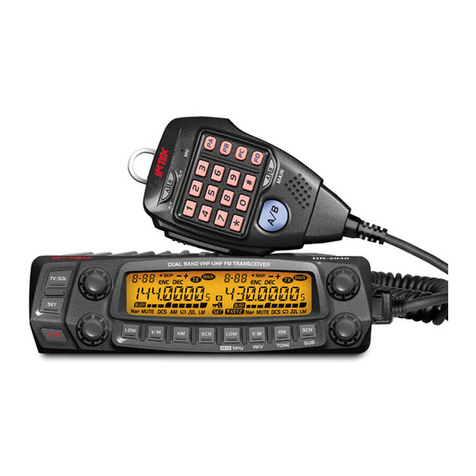
Intek
Intek HR-2040 owner's manual
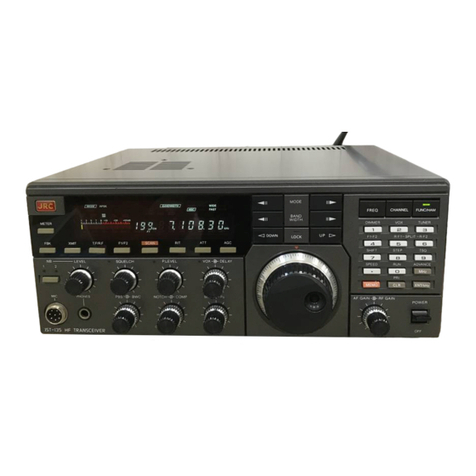
JRC
JRC JST-135 instruction manual
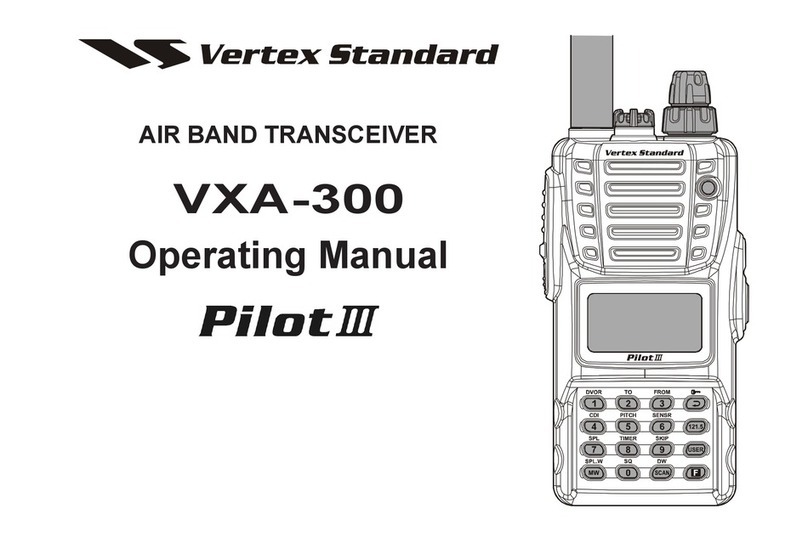
Verterx Standard
Verterx Standard VXA-300 Pilot III operating manual
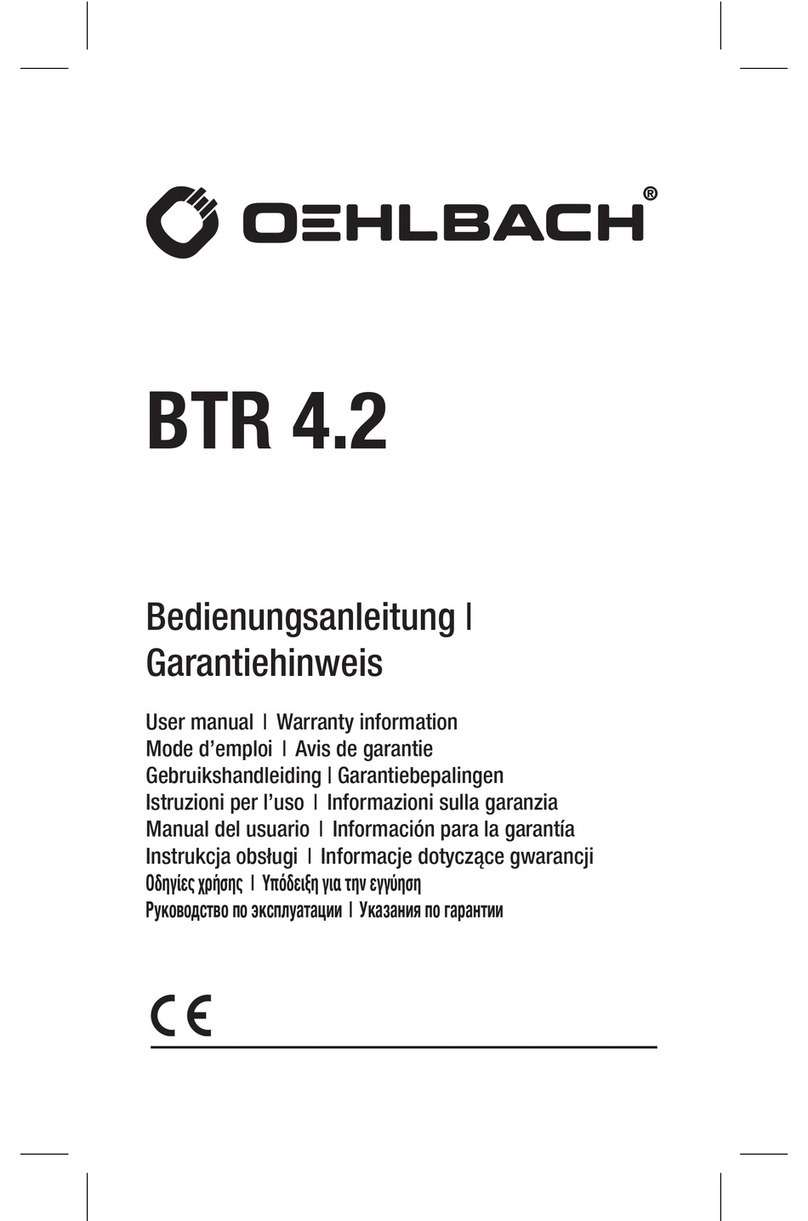
Oehlbach
Oehlbach BTR 4.2 user manual
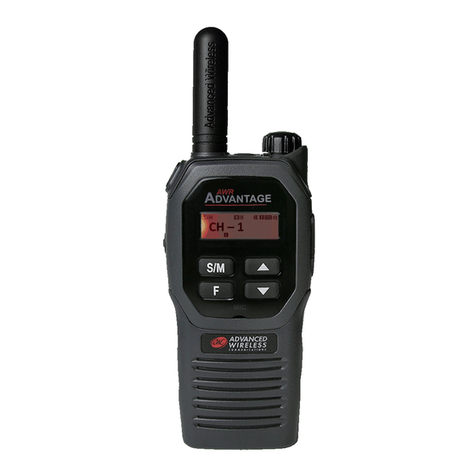
Advanced Wireless Communications
Advanced Wireless Communications AWR Advantage quick start guide
